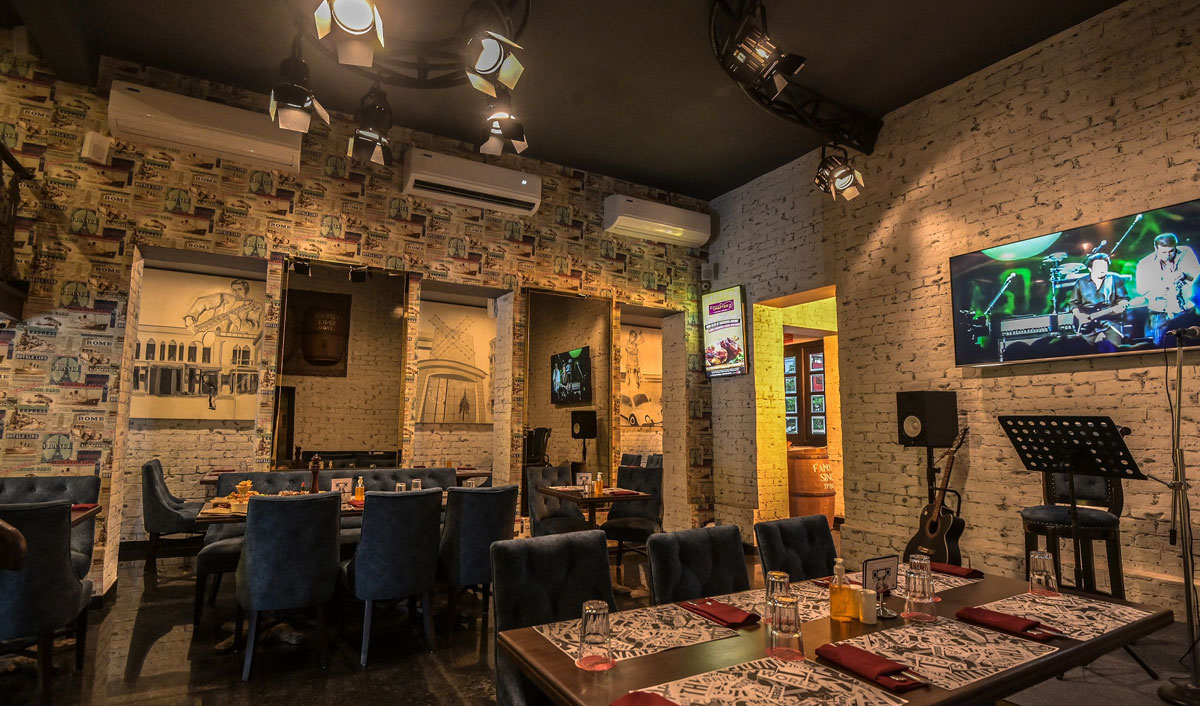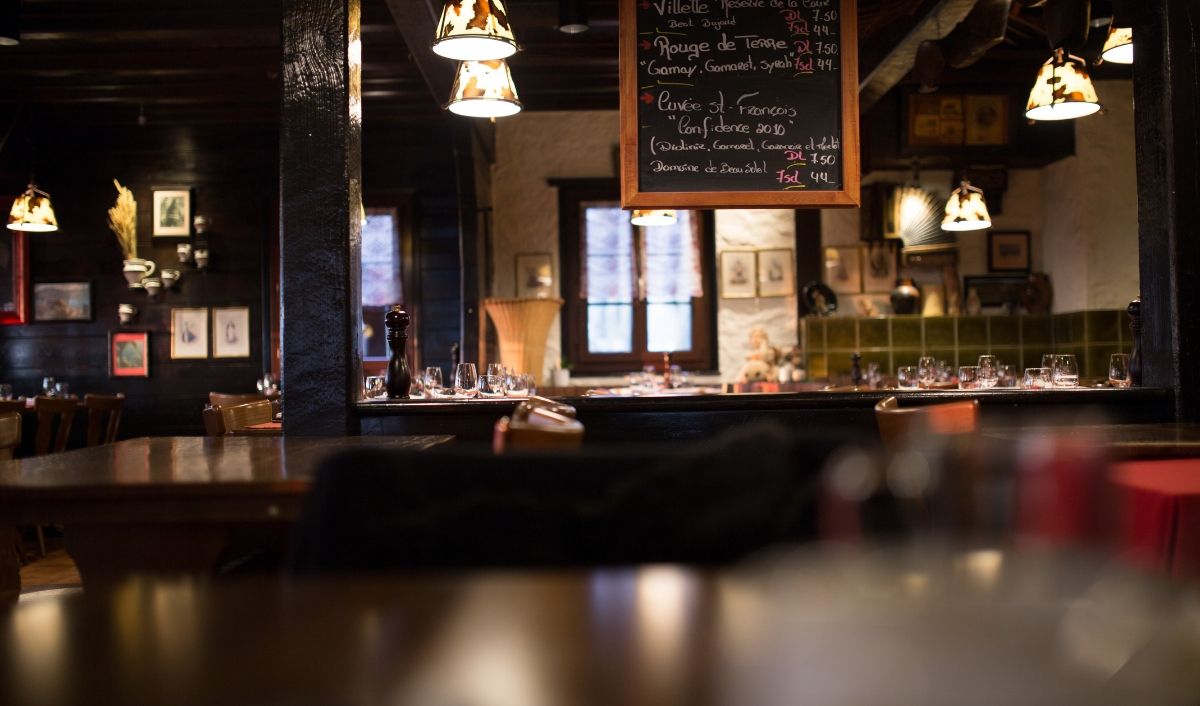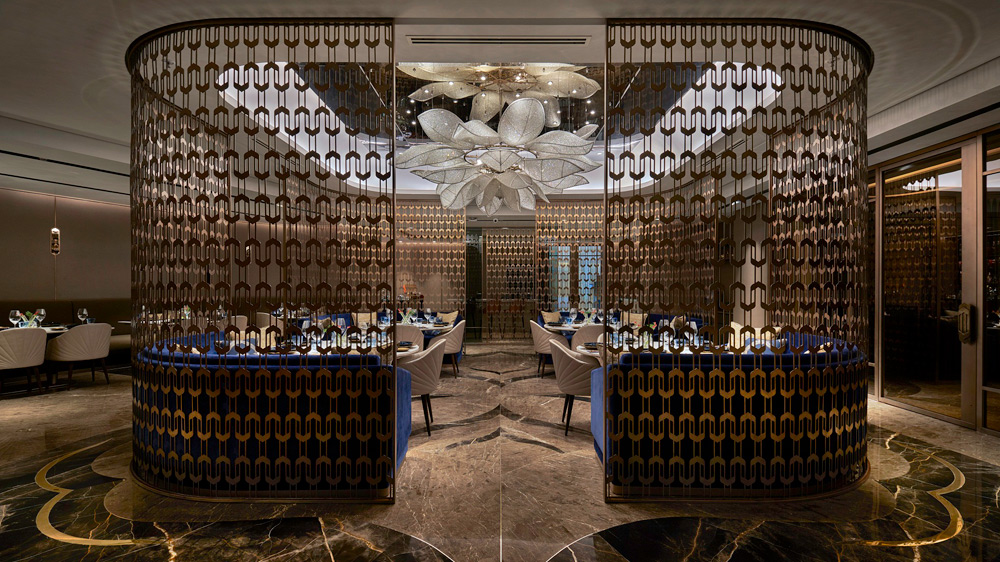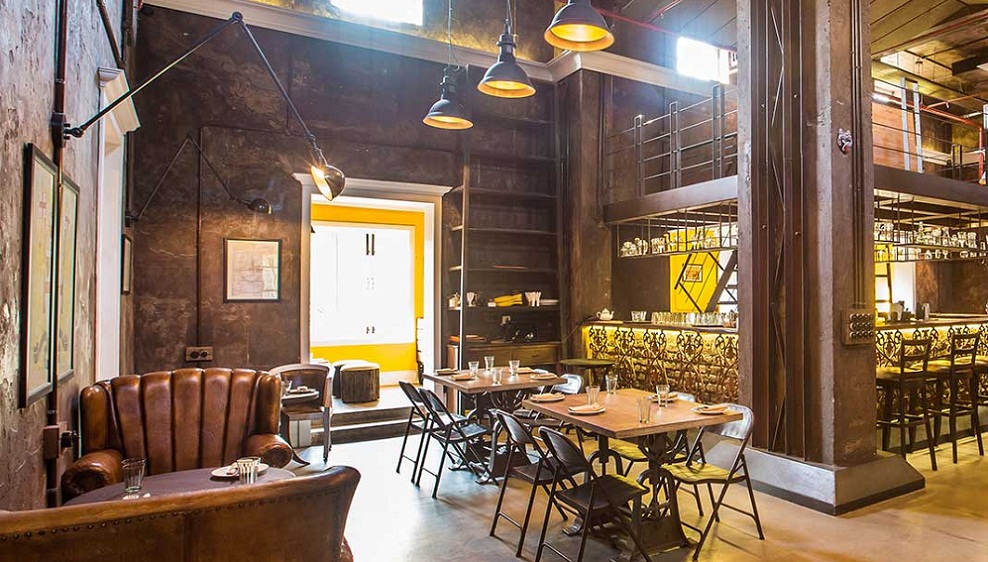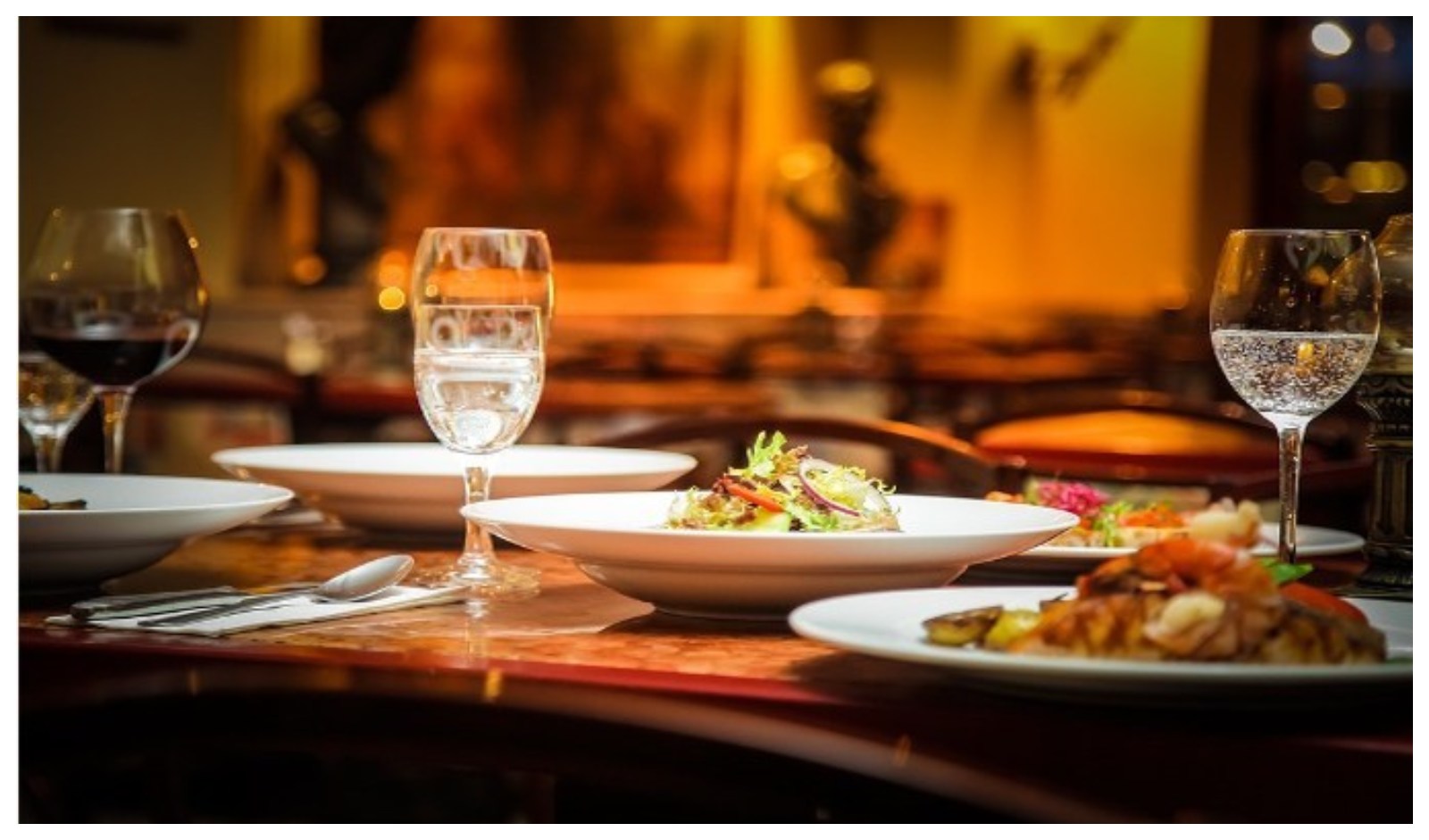
Tables spaced six feet apart, masked waiters and even glass barriers, these were some of the changes we came across while dining out during the pandemic. Whilst the global pandemic is coming to an end, there is a persistent concern about the need for social distancing in restaurants across the globe. The future of restaurant design thus looks way different from what it used to be.
Restaurants are exploring significant changes in the layouts, with a focus on limited social interaction between the patrons, the chefs and the attendants.
“With more diners choosing takeout and delivery options, restaurants are revamping their interiors. Fewer tables spread out, fewer bar counters and more open seating,” commented Jehan-Ara Poonawala, Chief Designer, JJ Poonawala Architects & Interior Designers.
This will further allow more space for cooking and preparing orders. Poonawala feels that smaller restaurants are the future and its best to avoid monstrosities with real estate and rent being big factors. “A standard prototyped design in with multiple small locations will earn better than one large space,” she said.
In order to design a pandemic friendly restaurant, a comprehensive study on mapping distances from points of ingress and egress, and from the dining space to the washrooms, will determine the layout’s overall effectiveness. The industry will see the demand for more open kitchens after the pandemic, as they promote transparency.
Typically, any eatery will seek to maximize seating capacities, optimizing every square foot to simultaneously cater to maximum visitors. “When one tries to accommodate all necessary protocols, I reckon the layout would effectively allow for seating roughly thirty per cent of the capacity that it is meant to serve. Restaurants thus will need to look beyond stopgap solutions to become viable again as businesses and that may very well extend beyond simply their design and layout,” Asha Sairam, Principal, Lotus Studio commented.
Re-thinking outdoor dining
The fall of Covid scare has also made restaurants rethink their outdoor spaces with restaurants expanding their dining options and converting grassy areas, footpaths, and streets to outside dining zones. Outdoor dining may in return become the biggest factor in diners returning to in-person restaurants.
According to Dikshu C. Kukreja, Principal Architect at C P Kukreja Architects, spatial planning too should undergo certain reforms such as socially distanced seating in restaurants, regulating movement in common areas such as lobbies, terraces, washrooms, and use of semi-open seating, gazebos and make-shift pavilions to accommodate individuals travelling in groups.
Porous materials like wood, cardboard, fibres, cotton, and leather seem to be a less stable material for the Covid-19 virus, which lasts only 24 hours on these surfaces. Antibacterial fabrics and finishes, including those that already exist, like copper, should be used.
“Even the use of materials will have to be more innovative, circular, and visionary; from its manufacturing, management, design, execution and recycling. We need to reimagine our restaurants to create more inclusive, conscious, and experimental designs, with a stronger focus on adding a tactile, humane touch to our increasingly digital interactions,” Dhruv Kalra, Principle Architect at I'm D'sign Studio added.
Along with the change of materials, heating, ventilation and air conditioning (HVAC) systems, and backend technology will need to adapt to the changing architecture. Technologically sound restaurants are now imperative for a successful operation.
In all the efforts to create a restaurant space more comforting and reliable for the patrons, one major aspect of sustainability should not be skipped. As Kukreja comments, “In our efforts to retain hygiene and clean environment inside, one must be mindful of the waste generated. Designs should be adept at optimized resource usage, minimised (or net-zero) waste generation and climatologically suitable.”

Providing you with an immersive experience of the lush green forests and safari in Africa, Ophelia at The Ashok in Chanakyapuri is revamped and has relaunched with a brand new concept.
Just in time for winters, the new concept has warm, inviting and earthy tones. Inspired by nature in Africa, the restaurant has elements of the jungle spread throughout creating a stark contrast from the previous floral and cool aesthetic.
Nestled beautifully in the tony neighborhood of Chanakyapuri, Ophelia returns as a whole new-haven of imaginative food, extraordinary drinks and rustic sophistication.
With a dramatic skylight that gently frames arched glass doors and bay windows, to let the softness of natural light seep into distinctive beige and grey accents with a sheen of brass peppered in, Ophelia awaits you. The walls are textured with Venetian stucco and the floor has a monochrome black and white marble element to bring more attention to the green and brown pantone paired perfectly with sepia and brass tones. Every element is handpicked to express a sense of calm and bring subtle sensuousness to the environment. Custom pendant lights inspired by the rich flora of Africa to Bohemian-African prints on the sofas, animal print upholstery on the chairs, the metal and jute railing.
“We’re absolutely elated to bring to you a revamped Ophelia, based on a completely new theme. Our aim with Ophelia has always been to make it a place where people get to not only relish the food but also enjoy the ambience, aesthetics and the experience that comes with it,” shared co-founders Akshay Anand and Ashish Begwani.
The featured cuisine at Ophelia is the best of global foods with a touch of modern sensibilities. Seasonal produce, contemporary techniques, innovative pairings and playing with traditions is the mood of the new Ophelia kitchen. Pair your meal with an extensive selection of wines from across the world, from French Cabernet Sauvignons to Italian Chiantis and Argentinian Malbecs. With eclectic Single Malts and blended Scotch, the bar also boasts of Mezcal and a host of aperitifs.

The Game Ranch has ventured into the Mumbai’s ever-growing nightlife scene.
Created and curated by dynamic restaurateur, Prasuk Jain who has previously run restaurants like The Game Palacio, Pink Wasabi, Snow World and many more unique spaces.

With a western influence underlying the new venture's entire ambiance, one can expect delectable food, specialty cocktails and an exciting gaming experience; presenting its audience with a distinctive escapade of the Wild West.

The Game Ranch is tastefully designed, comfortably classic and the food... incredibly diverse.

''The Game Ranch is that spot in the city that gives you a fresh burst every time you enter and completely changes your mood from the hustle of Bombay. We've created a space where once feels like they're in a fresh, lively and energetic vibe that completely lifts up the mood and brings in a sense of belonging. For us, it is about inviting people into a completely different world, especially for someone who loves the idea of a countryside experience,” shared Jain.

Nestled in the luxurious area of Powai, the interiors of the space have been designed by the in-house team with Prasuk. The place has a truly exquisite setting with a rugged and warm feeling. The interiors consist of wooden furniture that have earthy tones in the shades of brown, beige, cream, and taupe and the sheer detailing on the walls give the visitors an experience of being in a Ranch.

The burning ideation behind this space is to get engulfed in raunchy music, piquant platters, and old-American-style entertainment under one roof. Apart from the stunning aura and feel, this gaming resto lounge brings alive the authentic American, South American, and Mexican cuisines into our plates, right from wood-fired pizzas to divinely appetizing grills and Barbeque platters.

The contemporary, modern European restaurant Neuma is now open at Colaba Mumbai.
Co-founded by Indian filmmaker Karan Johar, Bunty Sajdeh (CEO, Cornerstone Sport and Dharma Cornerstone Agency) and True Palate Café Pvt. Ltd., it is located in the iconic, restored colonial-era bungalow on Mandlik Road in Colaba that once housed Indigo.

Neuma is poised to bring stylish yet relaxed fine dining back to one of South Mumbai’s most coveted locations.
Neuma is Karan Johar’s first restaurant venture, marking his foray into the hospitality space.
Pronounced ‘Noo-Maa,’ Neuma means the vital spirit that exists within each of us and connects us all, transporting one to a different time and space. This is especially prevalent in the restaurant’s design – conceptualized and created by Ashiesh Shah, Neuma serves as an architecturally-prominent landmark, presented in a new avatar.

The restaurant is divided up into separate, distinct spaces, each with a unique character of its own that is guaranteed to draw guests’ attention. Maximizing the available outdoor area, Shah recreates the architectural language around the existing greenery, retaining the hues of white, detailed carvings and stone pebbles. As guests arrive, they enter into the Garden Café, an outdoor area featuring a coffee bar and communal seating under the shade of a mango tree. Continuing on, guests will step into an oakwood sun porch area with a large skylight that provides a glorious tree view and admits an abundance of natural light, immediately creating a feeling of warmth and expanse. This leads to a Courtyard, complete with black and white old-world cement tiles, ceiling-high potted plants and detailed, moulded panels on either side, resulting in a breezy, laid-back vibe. Another outdoor area, The Safari, will instantly transport guests to the glamour of a safari odyssey.

Back indoors, the striking bar, aptly named the Rose Bar, is a sultry, sexy space realized in hues of red and characterized by a sculptural light fixture inspired by Anish Kapoor. It is reminiscent of a Moulin Rouge-esque boudoir, with its wood cladding, low-slung, velvet seating, fringed cushions and chandeliers that add a dramatic flair. Shah has selected real books that add to the décor in the space, in a case under the main bar, complete with red roses, that are also grown in planters outside the bar windows.
Guests can opt to dine in the white-hued, Danish-chic dining room, The Blanc, to the right of the Courtyard, which features more intimate seating and a whimsical vibe. The room is dotted with artefacts nestled in wall shelving designed to showcase them, and also in glass cases, just like one would see in a serious collector’s home. This space leads to the private dining area, also known as Verde, which features sage green chairs and curtains which separate it from The Blanc. The walls display braided ropes designed to imitate a woman’s corset ties and the Atelier’s signature Guccha light serves as the highlight of the space.
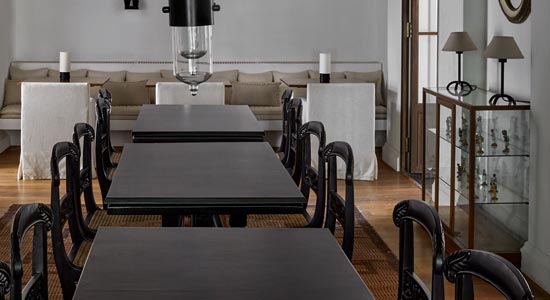
The kitchen is helmed by Executive Chef Abhinav Sharma, who is also the Corporate Chef de Cuisine for one8 Commune. The Neuma menu is a take on traditional European cuisine with modern plating and features produce-driven dishes designed to connect with the diner’s soul (as ‘Neuma’ the name suggests). A highlight is the vegan menu, created by renowned Chef Rishim Sachdeva, who was previously the Executive Chef at Olive Bar & Kitchen before moving to London to launch Tendril, a mostly-vegan kitchen. His consulting chef role at Neuma marks his return to the culinary landscape of Mumbai.

Neuma’s bar menu has been developed by Countertop India, one of India’s best-known bar and beverage companies, owned by Arijit Bose, with Zac Abbott consulting.
Owned by True Palate Café Pvt. Ltd. that operate restaurant like One8 commune which is an everyday bar, co-owned by Indian Cricketer, Virat Kohli. It currently has presence in 4 cities and by the end of 2023, it aims at having 20 outposts pan-India. Expansion plans in the UK and Canada are also on the horizon. True Palate’s upcoming brand, Pincode, a regional Indian restaurant that is in equity partnership with renowned chef Kunal Kapur, is also opening its first flagship outpost in Dubai this year.

Azure Hospitality has launched its casual dining restaurant Sly Granny to the shores of Goa through its Tereza beach house avatar.
Founded in 2010 by entrepreneurs Kabir Suri and Rahul Khanna, the menu is created by Chef Utkarsh with utmost care for local ingredients and culinary traditions.

“Our vision has always been to take our brands into local communities and neighborhoods, give them quality, a fun, and young experience, and put smiles on our customers. Goa has been particularly dear to us given its unique history, epic beauty, people, and traditions, and we are humble, excited to be able to serve it with our trademark azure style of hospitality,” shared the co-founders.

Sly Granny celebrates the life of a wicked, smart, wise, eccentric, polymath Granny. A polyamorous phenom with varied gastronomical interests, prohibition-era cocktails, and a bunch of well-selected wines for urban dwellers and other creatures of the night.

Founded in 2015 and laced with European tapas and global cuisine for those with a discerning palate, also curated oddity filled community houses and outposts in Delhi’s famous Khan market and on a rooftop in the tree-lined lanes of Indiranagar Bangalore.

Brand chef Clyde Jude is executing the everyday operations and overlooking the up and running of the restaurant.

Ready for a one-of-a-kind rooftop experience in the capital city of Goa? Good news for all food lovers as the city is welcoming the first and the highest rooftop restobar in Goa.
Located on the 11th floor of The Crescent Hotel, overlooking the Miramar beachfront - Raki Modern Mezze is the city’s first mediterranean rooftop restobar.

Rakshay Dhariwal from Passcode Hospitality, Chef Rahul Gomes and sisters-in-law duo Sahana Kumar Monserrate and Jennifer Baumgartner Monserrate have joined forces to bring to you the finest modern version of Middle Eastern cuisine at Raki.
Inspired by the national drink of Turkey, raki, a liqueur made of twice-distilled grapes and anise, this plush space is the first in the country to serve Raki. The drink raki is also called the lion’s milk because of its cloudy appearance and at Raki it is served as an aperitif.

“We are extremely delighted to bring to Goa some of the finest Mediterranean delicacies with the launch of Raki. Being one of the most vibrant cities in India, it was only natural for Sahana and I to introduce this cuisine to bridge the gap amongst the pool of other cuisines available in Panjim. The ambience of the restaurant oozes sophistication with palettes that accentuate a wholesome and welcoming vibe,” shared Dhariwal.

This 55 seater upbeat restobar offers a modern twist to Mediterranean dishes along with their wide variety of cocktails created to showcase the versatility of flavours and colours of Goa.
Designed by Rahul Gomes, Head Chef at Raki, the menu includes a variety of dishes like Labneh Za’atar, different types of Hummus(especially the Edamame Hummus with Chorizo), Toum & Harissa, Feta & Okra Gozleme, and the Pides with truffle oil and burrata cheese amongst others. Most of the spices used on this menu are imported from the Middle East to keep the flavours authentic.

The interiors of Raki are luxurious yet minimalistic, with a play of rose gold and teak wood, accessorized with gray and teal furniture. Raki has been designed by Archizi Design and Alan Machado keeping in mind the feel of a lavish penthouse with a 180 degree view of the Miramar coastline, a sun-roof for a ceiling, an exquisite bar and with indoor dining and bar seating, and outdoor lounge seating.

“Living in Panjim for the last 7 years, I realized the dearth of good Middle Eastern food, and as the opportunity presented itself, I decided to give the rooftop of our hotel an international feel with modern Mediterranean and easy finger food,” added Sahana.

There’s nothing more enlivening than meeting up with your favorite people after a long hectic day at work, or just allowing yourself to enjoy the weekends! If you are a party animal and are dying to party now, here’s the ‘perfect place in town’ for you.
Renovated in a new avatar, PPT (Perfect Place in Town) has re-opened its door for customers. Spread across a 12,500 sq.ft area, the place is divided into an in-house dining section and a breathtaking green and open terrace.

“We are thrilled to be back again with a bang in the City of Joy. We look forward to welcoming our guests to return to the lively fun times, enjoy signature beverages, scrumptious food, groove to cheerful music and sparkling entertainment,” shared Subhajit Mondal and Rishab Killa, Director, Perfect Place in Town - Kolkata (PPT).
Its USP lies in its spectacular interior and decor. The magnificence imbued into every element gives the place a touch of modernity with a vibrant twist that will leave you spellbound.

The 350-seater lounge also presents a thoughtfully crafted menu by Chef Vicktar Ghosh, featuring innovative dishes from a variety of world cuisine such as Italian, Indian, Mexican and more.
The unique madrix lighting creates the perfect setting for the night as you dance your heart out to the energetic tunes of the DJ.

The bar menu will boast a selection of uniquely crafted cocktails by the in-house mixologist offering the perfect experience for those with a taste for finer things in life.

So, boost your lounging experience under street-style lamps, geometric and abstract decor, all while relaxing in the sight of the city skyline overlooking Salt Lake and surrounding water bodies.

Shangri-La Bengaluru is all set to introduce a unique dining concept for the first time with a luxury dome perched on Level 19.
Guests, along with their loved ones, can recreate Shangri-La moments in a private dining bubble with themed décor and mesmerising views of Bengaluru’s vibrant skyline.

On the list are Indian, Asian or European themed decor sets that diners can choose from while pairing it with any of the five curated menus.
Chef Ashok Bandaru and his team of culinary talents have designed the special dinner table d'hôte featuring handpicked delicacies. Diners can select a hearty Indian meal with flavourful mains and small plates to Japanese signature delights or quintessential European delicacies with a contemporary twist.
End the meal on a sweet note with a marvellously crafted one-of-a-kind dessert replicating the shape of a dome.

With the perfect golden hour backdrop, afternoon tea-goers can also enjoy a decadent teatime with an array of sweet and savoury creations from 5 p.m. to 6 p.m. For those guests who like to indulge in refreshing sips and small bites, the dome can also host a delightful tapas session from 11 p.m. to 1.30 a.m.
Ideal for a romantic dinner, family gathering, reunions, birthdays or anniversaries, the social bubble provides the perfect celebratory surroundings for up to six guests.

To amplify the moment, each dome comes with a personal butler and a music system.
This exclusive dining destination starts at INR 2500, plus taxes, for one and is exclusive of booking charges.

The Dubai-based pure vegetarian resto bar, EPITOME is all set to lure diners at Juhu in Mumbai.
Operated by one of the partners at Silver Beach Hospitality who owns Colossal Hospitality, which has pioneered in introducing international luxury dining experiences.

“We are elated to be associated with the largest vegetarian restaurant in South Mumbai. Present in the eclectic and fast-evolving location, we are all set to open doors in Juhu which is going to be bigger. The menu is designed in a way that it caters to all patrons, offering unique twists, innovative techniques coupled with high-quality ingredients. Our team’s commitment towards impeccable hospitality along with serving flavoursome delicacies surely make Epitome a favourite restaurant among diners in the city,” shared Shrey Vishal Karia, Director at Colossal Hospitality.

Creating a relaxed dining environment feel and situated at the heart of Lower Parel, the present restaurant specialises in offering over 6 different types of cuisines, exquisite cocktails and an array of desserts.
Epitome, a 140 seat restaurant offers an all-day dining with their ever-so-popular dishes like Veg Kheema Pav, Pindi Chole, Epitome Special, Avocado Tikka Masala, Avocado Pani Puri, to name a few.
The menu caters to innovative and contemporary tastes of all palates and flavours designed by the Head Chef, Prakash Joshi. With a special kids menu to popular Asian & Lebanese dishes adored by all, Epitome ensures everyone goes home with a happy belly.

The award winning Mixologist, Mahesh Panigrahi, boasts about the signature concoctions that are a part of the menu. The menu includes Gin cocktails with a modern twist, dessert cocktails like Happy Wednesday with a Gin base, blackberry & honey with a dash of cream, to the classics like Cosmopolitan, Long Island Iced Teas, and others.
Every corner of the place oozes style. With interiors designed by Sumesh Menon, the ace interior designer, Epitome is an ode to the beautiful roman era with gothic elements to marvel at. Right from capturing European culture and making a fusion of modern and old school feels, Epitome beckons and makes people wish that they never had to leave.

Epitome is ready to cement its presence in the suburbs of Mumbai, and a second outlet can be expected to launch soon.

The rise of the Coronavirus pandemic has directly impacted the restaurant industry and has dynamically shaped the industry to adapt to the current circumstances. Understanding the industry disruption, the place has left no stone unturned to prove themselves resilient. From enhancing new interiors, to bringing new design trends the foodservice industry has certainly pivoted to new offerings to keep afloat in these difficult times.
Here are some enduring design trends in interiors & architecture that we are seeing in restaurants post-pandemic-
Expanding outdoor dining: The pandemic has forced many restaurants to change how they usually operate, dining out took a big hit, many restaurants expanded their outdoor dining space, using parking space or other outdoor space was in trend. In some cases, places having existing outdoor space got it renovated adding new life to open area making it more welcoming and exciting for their guest to sit and chill safely. Keeping safety as an utmost priority these outdoor seating had Plexiglas barriers between booths encouraging guests and customers to maintain social distance.
Digital transformation is on its way: The restaurant industry is developing and leading to new technological advancements in this space, having said that QR scans or codes are one thing we could easily find out post-pandemic. These quick-response scans have broadly replaced printed offering menus in cafes, bars keeping interactions contact-free all you have to scan and order or pay. This digital transformation has truly leveraged the capabilities of restaurateurs to learn how to meet the demands of modern-day customers.
Open kitchen to gain loyalty: The restaurants even changed the layouts also wherein instead of having the kitchen at the back, having an open kitchen and table around the kitchen wherein food will directly be served on the table was more comforting and promising for customers. These open kitchens just not only allowed guests to just come and dine in but they could see how safely their food is prepared.
Curbside pickup and drive-thru designs: Drive-thru gained immense popularity over the last year as the coronavirus pandemic closed indoor dining and made consumers not enter the restaurants & big chains. The restaurant industry is bringing innovations & creatively adding the latest design trends to their space to help enhance the safe & enjoyable dining experience for their customers.
Creative Partitions: With most of our daily lives confined to the home, the importance of having separate spaces in the restaurants is what customers like the most. Dinning is an experience; a simple addition of wall effect will create a brand new experience for the customers. These partitions enhance the diner’s experience creating safe, flexible areas improving the beauty of each portion.
Rooftop dining space: Rooftop dining spaces have always been popular and loved by everyone but after the pandemic, the rooftop place in restaurants got a new breath ie restaurateurs heavily invested in the decor of their rooftop making it an attractive place to dine in. The place is open for business all year round be it winters or summers, the rooftop dining is famous among millennials, youngsters who crave to vibe in both weather and place.
Making it more photo-friendly: In the age of Instagram, restaurants find a way to look unique and different and this is when interior design plays its role. In today’s time youngsters, millenials love to post where they have been all day long. To make sure your restaurant looks instagrammable you need to go with the trend, adding certain designs, bold text can easily help your place grab attention and new customers.
Comfortable seating: Everyone today wants to be comfortable and finds a space which can be called “my space”, due to the office’s closed colleagues and team members love to meet outside to enjoy or have short meetings and spend time working there for longer & longer hours. Looking into these restaurants has placed cushioned seats, chairs into their dining floor layouts.

Dining areas are the most succulent spaces specifically in 5-star properties. The experiential factor that the guests look forward to when visiting or staying in a hotel is manifested through its Dining area. The space influences appetite, experience, conversations and initiate togetherness among the guests and serves as a focal facet for their vacay time.

Haridwar is an ancient city and important Hindu pilgrimage site in India, where the river Ganges exits the Himalayan foothills. It is the city known for the strong influences of the deity Shiva, further enhanced by the presence of the river Ganga.
Pilibhit House, a mesmerizing hospitality project in Haridwar by Designers Group, seeks to enthrall everyone who enters the town searching for liberation (Moksha). The cultural and religious significance of Haridwar played a considerable part in the contemporary design grammar of the Pilibhit House Hotel. This vintage property, situated on the banks of the river Ganga, was owned by the descendants of the royal family of Pilibhit.
The project was first initiated by the late Ar. Pradeep Sachdeva. After his untimely demise in 2020, this project was handed over to Designers Group. Later, Mr. Sachdeva’s team continued to work on the architecture of the property with Designers Group for the successful completion of the project.

As the project was assigned to the Designers Group in June 2020, a time when the lockdown was strictly implemented due to the COVID-19 pandemic, the team faced a crucial challenge. They had to design without making in-person site visits and by taking virtual tours of the assigned project while it was under construction.
The hotel is a kaleidoscope of cultural influences and civilizations, an idea demonstrated by the holy city of Haridwar, where people from all over come to attain Moksha.
The dining area was devised to denote the Kama. The Neel Kanth colour of the Nandi evident in the exuberant wooden hand-painted ceiling with gold accents here reflected the presence of Lord Shiva. The classical influences in the area boast of the Indianness rooted in the hotel. A wall installation assimilated here is inspired by a holy-book reading-stand where the Granths (holy book) from usually every religion are kept, manifesting oneness and secularism of the country. Another light installation hovering over the buffet counter stimulates the sanctity of Shiv Kalash in the space.

The design of this dining space seamlessly puts forth Indian culture in a modern design tone, showcasing the traditional schematic approach and rich temple colour palette. The cultural and spiritual significance of Haridwar plays a considerable part in the contemporary design grammar of the dining area at Pilibhit House by IHCL SeleQtions.

Glass, a modern Indian restaurant and bar curated by Chef Abhijit Saha at Brigade Group owned Holiday Inn Bengaluru Racecourse opened its doors to patrons today.
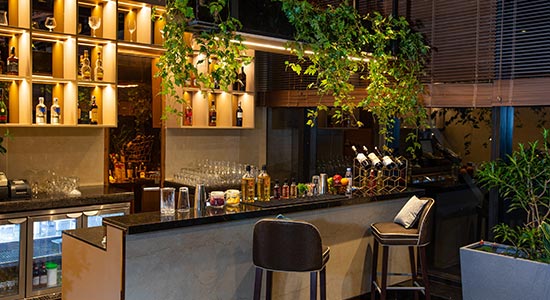
‘Glass’ has been conceptualised with a difference – to recreate traditional Indian food served with modern presentations.
“The idea to set up ‘Glass’ came about post the second lockdown in the country. The team at Brigade Hospitality wanted to create a special and exciting space to re-energise Holiday Inn Bangalore Race course and what better way to do it than by launching a restaurant that would leave a lasting impression on the city? There was no better person than Chef Abhijit Saha to lead the way,” shared Nirupa Shankar, Executive Director, Brigade Enterprises who believed that chef Saha has always been a forward-thinking chef, creating food that is cutting edge and ahead of its time.

Designed in an indoor garden setting, ‘Glass’ radiates a bespoke ambience.
The menu includes traditional cuisine from different regions of India complemented by an exhaustive selection of drinks.

“Glass is based on clean food, interesting flavour combinations and sustainable dining with a focus on farm to fork. Food lovers can indulge in the finest Indian cuisine with a creative, contemporary and eclectic feel. Our menu exudes imaginative interpretations of traditional cuisine from different regions of India with exciting flavours served with modern presentations,” added Saha.
The restaurant also has a Speakeasy Bar with innovative and classic cocktails along with a wide selection of fine spirits, beers, wines and exciting small plates is perfect for unwinding and relaxing with friends creating a unique bar experience.

With a good balance of Chef Saha’s specially curated innovative foods, flavours and comfort foods, Glass, the new go-to place in Bengaluru, offers to the discerning foodie picture-perfect food that delights the taste buds too.

This newly opened BYOB space named Western Village is one of the best places to bring your own booze and indulge in delicious delicacies while enjoying an indoor as well as open sky dining space.

Lush greenery, playful interiors comprising private cabanas and an awesome evening is what they promise. Western Village serves mouth-watering delicacies like Dohra kebab, Peppercorn cheese roll, Dal Makhni, Butter chicken to name a few. It has a welcoming ambience, a unique theme along with a good value for money, hence making it a go-to place to hang out with friends for a good time.

Being a huge party place, it offers some lip-smacking food and mocktails, and foot-tapping music.
“We wanted to come up with a space with a quirky ambience for our patrons alongside a delectable menu which caters our target audience. Creating a range of palatable dishes with a modern-Indian twist with the help of our head chef Kapil Joshi was a no-brainer since it’s very popular cuisine these days,” said Shekhar Sharma, Co-founder, and Owner at The Western Village.

It is situated far away from the hustle-bustle of the city which makes it a popular stop for the youngsters, who don't mind getting away for a long drive.
This place will give you a shack-like dining experience that you probably might have experienced in Goa. It’s situated right adjacent to a well-stocked liquor shop, making it the perfect BYOB place in Gurgaon.

Celebrating the tastes, textures and forms of distinctly authentic vegetarian dishes from across the trifecta of Laos, Cambodia and Vietnam - Plural is Mumbai’s primeval restaurant to take a locavore approach to sustainable vegetarian and vegan-friendly dining in a communal setting.
Nestled in Kala Ghoda quaint by lanes, Plural seeks inspiration from its founder Vedant Shah’s travels from his stint in the USA and across South-East Asia.

Deeply influenced by the culture of the region and its distinct expression through food, the newly launched restaurant and delivery kitchen is flavorful and experimental - reminiscent of the ‘plurality’ of Shah’s culinary experiences that he now envisages bringing back to India.
“It all started with a steaming hot bowl of pho ordered at a neighbourhood Vietnamese restaurant during my university days in the USA. The dish made an enduring impression; I was hard-pressed to find something as fresh and uplifting. My passion for food burgeoned over the years and it inspired me to travel, learn and ultimately take the leap of faith," shared Shah, an industrial engineer by trade who pivoted from the healthcare space to F&B with no background.

One of the restaurant's cultural underpinnings is its environmentally conscious ethos, which draws from the use of eco-friendly packaging and mindful sourcing practices of high-quality, regional produce to reduce carbon footprint. Ingredients are responsibly sourced from local vendors who deliver fresh harvest on the daily, thereby ensuring high standards in flavor.
“For us at Plural, customer experience (the sum) ought to be greater than our individual efforts (the parts). We thus aim to re-introduce storytelling through innovative yet approachable food in communal environs - where our culinary team takes a slew of strikingly fresh ingredients and weaves them into a handsome memory of something ripe and distinct on the plate - hitting all 5 flavors along the way and packing tons of flavor in every serving,” he added.
The menu is divided into Salad & Soups, Small plates, Staples, Large plates and Dessert - each having signature dishes of their own to best suit the palate.

Plural's cocktail program is thoughtfully curated to complement the food and the varying preferences of patrons. Each concoction pushes the envelope, whilst maintaining a familiarity resonant to the Indian palate all the same.
The ambience is vibrant, lively and intimate - much like the feel of a posh yet approachable Vietnamese dining square. As its name suggests, the space is designed to enable diverse guests to engage with each other and their neighbours with a shared love of food. From the textured wallpaper to the pickling and infusion jars on display, many elements from part of the interiors deepen the sensory connection to the cuisine.

Adhering to the norms of health and safety, the restaurant has only been servicing home delivery requests thus far.
However, it has now opened its doors for customers to walk in and also ontinues to deliver food via its website between Cuffe Parade and Juhu, from 12 noon till 10 pm.

Adding to Ar. Abhigyan Neogi, Founder at Chromed Design Studio’s array of international projects is the newly launched Glo - an exclusive, high-end resto-bar located in the heart of Dubai International Financial Center (DIFC).
As the name suggests, the key features at this exuberant diner are the glowing arches and luminous globes which light up the entire outdoor space and the surrounding water body. Offering a diverse experience indoors and outdoors, this physical space has been designed to manifest a myriad of sophistication.

Providing an illusion of the outdoor space glowing in a pool of water, Ar. Abhigyan Neogi has created a light spectrum that fabricates a high-energy vibe making the entire area glimmer in the dark. Presenting an unparalleled experience of a mirage, the colour palette and the lighting scheme chosen are vibrant and lively. The bar is divided into two zones- the indoors and outdoors, each carrying its own personality yet merging as one. Complementing the interiors with the exterior radiance, the elegant indoors comprise of rich tones with opulent gold accents. The lighting fixtures including dramatic pendants in the indoor area are in impeccable symmetry with the outdoor lighting scheme, formulating an overall gleam of shine in this upscale bar.

Keeping the main focus on the outdoors, the water body around the podium binds the view by reflecting lit arches and LED globes which create a mirage of lights floating in the water. Metallic furniture is incorporated with a powder coating over the bar stools and sofa against rusting. The tabletops are made using onyx marble encased in a metal framework. The outdoor furniture is inspired by Paula Lenti, providing spirited and funky energy. A contrasting colour scheme of rust and teal on a grey background is induced to accentuate the seating area. The outdoor bar has a red onyx marble countertop with fluted MDF and a step bar back paired with huge dangling chandeliers over them. The DJ console is synced with the bar and is made in transparent acrylic. The speaker set is provided with the smart use of lights on the edges and on the front to give definition to the transparency.
Also Read: 4 Things to Keep in Mind while Designing your Restaurant
Moving into the interior zone, the decor here is adorned with wooden arches encased in SS brass sheets to follow the concept of the outdoors. The wallpapers are opulent and rich in schemes of purple and wine shades on a floral theme. Furniture upholstered in dark velvets offers a luxurious atmosphere. The indoor bar also maintains the red onyx marble countertop with a lighted-up sheer curtain covering the front of the bar.

The material palette of the project consists heavily of terrazzo, wood, and steel. Keeping the design minimalistic, diagonally patterned terrazzo tiles are used for the flooring with SS inlays included in grey and black terrazzo. The lighting pattern is also synced with the outdoor bar which was controlled through the WiFi that could come in handy during the harsh summers of Dubai.
May Interest: How does the restaurant design post-pandemic look like?
Presenting a dynamic depth to the designed space, the project showcases an uplifting yet serene environment with the interplay of lights and textures. Keeping up with their exceptional designing prestige, Chromed Design Studio has once again created an unforgettable experiential space in the Emirate.


Calcutta’s culinary landscape has been witnessing a wave of innovation with unique new spaces opening doors in recent times. The stellar ranks of the city of joy’s exquisite bars and lounges have been adorned with a dazzling new jewel in the crown.
The newly launched BILLIONS is located in the heart of the city on the 1st floor of Trinity Tower in Topsia.

The magnificently designed ‘uber house’ appeals to Calcutta’s elite and aspiring offering grandiose in its ambience and the spread of global cuisine.
Also Read: Redefining nightlife scene at Kolkata, Vertex – The Liquid Restaurant opens its doors
The restaurant offers a menu that focuses on world cuisine featuring Modern Asian, Modern Indian, American, Italian, Japanese, Thai, Malaysian and beyond. DJ Cas, the in-house vibe master sets a high-energy mood at the bar, with foot-tapping music.

The 120 plus seater, spread over a massive, sprawling area of approximately 8500 sq. ft. plus, is divided into 5 unique sections; the extensive dining area – BILLIONS Dining, the magnetic bar-side seating – BILLIONS Bar, a small, cosy, private room for limited groups of guests – BILLIONS PDR, a more spacious and grander private room – BILLIONS Den and the smoking area set in a corner that invites a flood of natural light – BILLIONS Balcony.
“With a deep sense of pride and inexplicable excitement, BILLIONS has been launched as a space that does not shy away from celebrating each one’s worth. I am thrilled to bring to our city a lounge that is entirely new in its perspective and concept. With the experience that I have garnered in the F&B industry, I hope to drive the brand towards heights that inspire,’ shared Devraj Dutt, Founder & Owner, BILLIONS.

May Interest: "Annakoot – God’s Own Cuisine " launches 3rd sattvic restaurant in Delhi
Not to forget the signature currency-themed cocktails brewed up by the in-house mixologist, “The Billionaire”, “The Billions LIIT”,“Candy Crush”, among others, are crafted to cash in a billion rich, exoticflavours for your taste buds, leaving you craving for more. The lounge also offers a selection of ‘craftails’, which are lip-smacking cocktails from the tap!

BILLIONS aims to establish itself more as a lifestyle, a state of mind that the city’s elite connect with and enthusiasts aspire to reach.

Designed in parity to the booming café culture in the city, Anand Sweets in Whitefield is a boutique store and restaurant that provides its customers with an indulgent shopping and dining experience.
Conceptualized as a young, chic and vibrant space, Almond House creates a sensorially indulgent play of different materials.

Contemporary and luxurious, the interiors are a medley of modern colors and textures, housing fun and quirky patterns, cleverly incorporated within the surface finishing, lighting and furniture details.
Anand is heavily influenced by the youth culture and caters to their unique needs. The interiors explore the power of the eccentric color combination of black, white and gold, along with the drama of the changing forms of a line. The black and white palette with a hint of metallic glamour unfolds into a celebratory colour palette with quirky signages and imaginative patterns as the space progresses, thus creating a memorable experience.

This modern and youthful interior is primarily zoned as an entrance, a boutique retail and a restaurant.The visitor is welcomed by a chirpy green wall at the entrance with a luxe marble textured frame and a backlit golden toned signage, setting the tone for the overall spatial experience. The main entrance opens into a functional and dynamic space, highlighted with a black and white chequered floor, further complemented with a wooden ceiling and the contemporary colonial chandelier.
The wooden ceiling rafters flanked by a series of minimal, curvi linear skeleton arches, imagined in glass and matte black metallic members, along with the white marble textured display counter, the golden striped wall and the minimal floating counters, visually guide the customer for a quick spatial overview.

The boutique retail entrance is marked by a zig zag, black and white marble floor, reflected back from a quirky chromatic mirror display, and framed by the metal and glass arch with focus lighting. The photo chromatic display plays with the customer’s perspective, creating a unique view for each person based on their individual angle, creating an interactive experience. The minimal geometric wall displays, the mirrored waffle slab ceiling, backlit mirror, plush furniture, and sleek metal finishing in gold and sumptuous chandeliers create a bold and striking aesthetic that emanates a dreamy, urbane and ultra-modern ambiance.
The restaurant is marked by an artistic poster of ‘PuraniDilli’, which is a contemporary take on the nostalgia and hustle bustle of the olden markets and eateries. The dining area is designed in neutral shades highlighted with rough wooden textures, colorful patterned wall and floor tiles. The high contrast design language of the retail section subtly transforms within the restaurant to a more relaxed, warm and comfortable ambiance.

The bright tile patterns and vibrant graphic posters bring in the rich visual experience of Old Delhi, reinterpreted in to an artful, spirited and aesthetic decor. Simplistic rough wood furniture, minimally patterned display counters and nonchalant metallic chandeliers highlight the sentimental and luxurious appeal of the space.
Aimed at creating an artful and delightful spatial experience, Anand Sweets redefines the Indian Contemporary by including the human experience into the design, thus creating elegant, interactive spaces. It is an intricately detailed space with a symphony of colours, materials and patterns that create a fluid interior, integrating the entire space into an innovative and modern ambiance.

Diversification has always been one of the most significant characteristics of Indian culture. In terms of design too, various projects especially in hospitality sectors, explicitly showcase the intricacies of the legacy we all are a part of.
Indianisation is the Core
In this recently completed project called The Grey Room, Indian designer Saheba Singh of This Is It Designs sought to accomplish the amalgamation of modern India into the cosmopolitan skyline of Tokyo. Located in one of the busiest shopping districts in the city, this restaurant serves to conglomerate the contemporary aspects of our design sensibility with the ‘larger than life’ semblance of the metropolis.

The implementation of this interior design project was in complete harmony to the restaurant’s desire of creating a frame consisting of both Indian and Japanese elements. Thus, the design team conceptualized a space that could portray the traditional components of Japanese culture intertwined with the golden opulence of India.
Also Read: Why Culture is an Important part of Restaurant Design
Executed with the unison of three professional of this divergent country; Chef Ravi Tej Nath, Owner Sunandan Kapur and Designer Saheba Singh; this project at its core aims to celebrate the congruence of Indian and Japanese values – with a touch of sophisticated boldness.

“Exploring the true colors of the given space while subtly amalgamating the users and other intangible aspects, as a significant part of the whole schema,” shared Saheba Singh, Director - This Is It Designs Pvt. Ltd.
Mirage of Culture
The intersection of the two rich thought processes have been inculcated from the inception of the design itself, through the placement of a solid hostess desk glistened with a layer of gold leaf. Symbolic of the monolithic texture of Japanese civilization, the touch of shimmer is sure to remind any embarking user of royal Indian affluence. Perching forward, a combination of comfortable lounge seating and individual chairs tinted with shades of grey, successfully switch the neutral tone perceivable throughout. A rugged stone cladding in grey portrays the intricate history of India with context to its rock-cut design, while posing under a warm yellow lighting, thus forming the apt backdrop to this classy setting.

A two-step higher section, denoting the euphoric aura that is characteristic of this area, is what catches the next glimpse of the eye. Flanked by a long bar possessing a dark grey marble table top, serene seating options dressed in clouded monotones, effectively allow the user to dial down and indulge in the surrounding imperial luxuries. Yet another slightly segregated arena, can be glanced at upfront from the preceding area, placed to further permeate luxury to the encompassed composition. Located adjacent to the primary seating spaces, the private spaces posses a complementary indulgence of grey, established through the usage of concrete.

Design is the Key
An outdoor seating option, accessible through the commuting entrance lobby, showcases the impeccable ambiance to enjoy an evening while feasting on a spectacular view of the Megalopolis. Done in grey furnishings, the fervor implicated by the usage of hardwood flooring is judiciously contrasted with the weave of the upholstery, thus drawing a gracious bookmark to the culmination.
Must Read: Hiring a Designer for Your Restaurant? Look For These Five Qualities
To create an effective mélange of such contradictory textures and elements, such that it does not look fragmented, rather combines to form one unified picturesque layout – was the most crucial challenge faced by the design team. “Using minimal number of materials and implementing them in their utmost grandeur”, is what the Designer Saheba Singh conceptualized to accomplish in this one-of-a-kind project and was successful in uplifting it to the crescendo it deserved.

The Grey Room Tokyo is an inceptive idea that was executed to create a divergent lounge experience, which carries a whiff of the cuisine and exudes an omnipresent sense of poise, through its elucidative design demonstration.

The trend of eating out has seen a considerable rise, be it a college student, a corporate manager or a young family. Every now and then people are willing to set out for a bite, and indulge in the ambience that is served to them alongside the savour able delicacies. A divergent genre of the population in urban centres has led to multiple typologies of dining options, which primarily are either branded eateries or standalone restaurants.
Having worked with numerous esteemed brands, Ar. Ishvinder Kaur, Founding Principal ivpartners, states that,”Designing for a Punjab Grill is completely different from designing for another brand considering its legacy. Each of them has different prerequisites related to look & feel that needs to be met. Some prefer the utilization of opulent accents while some prefer muted tones.” “Standalones surely have a more flexible approach but if their design ideology is not impactful, it fails to excite its target audience at large,” stipulates Partner and Design Director Vikas Sabharwal.
Designing Architecture and concept
In interior design & architecture, these two genres of diners with respect to their planning, décor and conceptualization; are quite distinctive. The varied ideology that traverses its journey from conceptualization to realization, forms the primary difference between standalone and brand franchise restaurants. The perception that is pitched for the latter needs to be based on continuity & a carrying forward of the central idea. However, subtle changes are possible & much needed to be inculcated keeping the continuing string of thought. Ar. Ishvinder, elaborates, “We have designed numerous restaurants for Punjab Grill and even though all portray a semblance of opulent royalty, there is a nuanced difference in the appearance of the outlet at Kala Ghoda, Mumbai and the one at Khan Market, New Delhi.”
The Punjab Grill at Kala Ghoda, Mumbai caters to create a mélange of experiences through a contemporary portrayal of the vibrant Punjabi flamboyance. Possessing an all-day diner semblance, the interior design scheme carries a whiff of the cuisine served while plating a vivacious composition to dine in. Evident illustrations depicting the intricate legacy of Punjab, including the ‘phulkari’ and ‘jaali’ incorporated motifs, have been intertwined with the strings of efficient functionality and contemporary renderation.
Contrary to the above, the Punjab Grill at Khan Market in the capital is a fine dining created to cater for an intimate culinary experience. Khan Market, a well-heeled shopping & food destination becomes an apt location for an authentic North-Indian cuisine-inspired restaurant with an essence of nuanced décor. With a global design concept revolving around ‘the chef’, the details were evolved to carry flavours of the local cuisine. The design is circumscribed around refurbishing an architectural inheritance of the colonial era, and thus required the introduction of several amendments & on-site evolution of design planning.
Contrasting to the idea of brand-identified restaurants, standalones base their concepts on current trends & themes. They may vary from being centred around the cuisine served or the target audience of the space. Versatility and experimentation of approaches is what is inherently prevalent for this typology of diners and aids to keep its patrons engaged.
Creating a customer base
Franchise restaurants are affiliated with a unifying brand, while standalone restaurants are individual & unique. A branded franchise brings in the advantage of recognition, owing to the popularity it acquires with its meticulous & professional standards set in the industry. Therefore, opening a new outlet with a brand name fetches a premeditated customer base. There is an intrinsic trust value that is linked to the formats in which they present their cuisine and the milieu.
A standalone café or restaurant, on the other hand, has the job cut-out of building its target audience from scratch. It has a vantage point, owing to the fact that it is not streamlined by stereotypical assumptions and can commence its journey, on a clean slate.
Churning of the franchise model
The basic wheel of the economy for a label marked restaurants and standalone joints have an integral difference, in their management & functioning. The former genre has set rules and standards that have to be taken into accord during the entire business structuring. It cannot be based on random concepts and any amendments formulated are routed through a process and in a stipulated time span. However, the situation in the latter is much more malleable since the management is often regulated by a comparatively constricted group.
Thus, it may be concluded that standalone and brand franchises both have their pros and cons which have to be dealt with. However, as Ar. Vikas states, “The success finally of each of the concepts require a uniquely carved out design perimeter and an exemplary execution of intricate details that will impart the composition with a Midas’ touch.”

The updated acumen of global residents have caused a pragmatic change in the urban facades that curate the metropolitan envisaged around us. From residential to commercial complexes, all primary spaces that govern the daily lives of individuals, have witnessed diversifying changes that have resulted in trend setting stalwarts for design. The hospitality sector too has been a part of this paradigm shift, with the evolution of people’s taste towards spaces they desire to spend moments of frolic or respite. The key notion that plays the requisite trick for such arenas is primarily connected to being exclusive in the design concept that is portrayed and has a strong sense of being aesthetically unprecedented and unparalleled to any other diner of the same cadre.
Clarity on the genre of audience: Every genre of diner has a specific category of audience that it desires to charm, with the incorporated design typology and décor. Thus, it is integral to conclude with the concept and aesthetic appeal as per the admissible crowd. For patrons of opulence, schemes instilled with accents of gold and royal shades of maroon, work the drill; whereas with a bar/pub targeting the millennials, the composition has to impart the essence of ecstasy and euphoria through quirky lights, bold graphical representations and innovation illustrated through the details of design. This primary decision making will assist any architect or designer to lay the first stone of a successful strategy with much ease and competence.
A definitive design language: Any poignant interior design schema elucidates its narrative in a distinct language. It does not aim to confuse the user with any supplementary ideas that might astray the accentuation. For instance, in one of our recently completed projects ‘Kampai’, the theme was required to possess a Japanese neo-classical portrayal. Every detail instilled in that design complies with this conceived ideology including; the Noren curtains, kosithshu booths and the traditional furniture utilised. Yet another project titled ‘Prankster’ revolves around the reminiscent memories of college days. Hence, spaces that resembled practical laboratories, libraries with lighting formulated in the form of conglomerated books and hostel with bunk beds for furniture; were chosen to be utilised.
User-interactive: Being residents of the ‘Social media’ age, it is almost needless to say that the designed composition should include certain assets that can do its needful rounds in the newsfeed. It may be in the format of a generic ‘Selfie point’ or an arena that requires interaction of the audience with backstage stories. In the above mentioned project ‘Kampai’, an open sushi counter does the drill. It provides a small sneak peek into the master’s craft while keeping the audience on their toes. ‘Toyroom’, a project of international fame, had pieces of furniture sheathed with miniature mascots of the brand to serve the requisites of the label name and supplement the pictorial buzz on the internet.
Attention to residual spaces: Along with consolidating all innovative efforts on the integral spaces of hospitality design, it is pertinent to design the connecting spaces like corridors & entrance pathways with an equal amount of intricacy. This aids in maintaining the patron’s interest in the concept even while traversing his way across from one sector to another. LED Lights composed as words on the ceiling of the entrance passage and artistic displays of pop-artists as wall graffiti, serves as the mentioned ideology in ‘Toyroom’. An efficient planning with apt highlights harmoniously distributed across the entire layout, draws the image of a consistent design panorama, and thus never fails to impress the imminent user.
With the increasing number of options becoming available each day to the residents, it is imperative to be able to establish an impactful set-up, that remains etched with indelible ink. A well-weaved architectural endeavour, with a concoction of certain glistening factors, is apt brew that works its way through the audience and stands the test of time, with ease.

The most important element of Indian cooking “Maachis” is the ignition to the heritage of diverse Indian cuisines. The love affair of Indian cooking with a mixed bag of flavours, techniques and tales of different regions is housed at Ardee Mall in the bustling metropolis of Gurgaon.
From the makers of one of the leading & prominent Indian cuisine restaurant “Not Just Paranthas”, Varun Agarwal & Supra Agarwal brings MAACHIS – “Houseful of India”, a one-of-its-kind Indian Tapas & Cocktail Bar.

A creator of local regional dishes – MAACHIS renders age old traditions to create an experience that toasts to old times and celebrates the new.
“Extremely diverse & unique, India is a display of an array of flavours that dish out magic in a variety of cooking styles. However, food has one common start and that is Maachis,” shared Agarwal, adding that right from the makeover to the menu everything is very Indian here.

The modish construct of the restaurant, corresponds harmoniously with the tones of the space, the earthy contours and the minimalistic expression of the décor – class all the way! Right from the lights to the cane furniture, every detail in fundamentally Indian.
Created with a thoughtful attention & a fresh atmosphere – MAACHIS strips to essential in a way, still keeping a warm & welcoming emanation. An Indian Tapas & Cocktail Bar, comes with a coffee bar of its own. Adding uniqueness, modernity and panache of its own, Maachis is the new stylish to be place of the city.

With a fine and phenomenal approach, the Food at MAACHIS is a colourful curation of the Michelin recommended - Chef Gautam Chaudhary. Presenting the classics yet the unexplored charm of India’s diverse regions, the food here marries them artfully with familiar flavours.
From stylish Soups of Plum Tomato & Sweet Pepper to a traditional Chettinaadu Chaaru an aromatic elixir, Gosht Yakhni Shorba, walk into flavours of Regional Indian Salads from the tempered Beets & Coconut Salad to the burmese 1960 Atho Salad. The Regional Tapas tosses signatures from a Himalayan Spiced Mushrooms, Bengali Beetroot Chaap & Bhopali Bhutte ki Kees to Naga Ghost pepper wings, Shillong Shapale, Kashmiri Naan Kebab & Gondhraj Lebu Seekh Kebab scented with lemon leaves from Bengal. Bursting with flavours of the sea, relish Fish Polichattu, Goan Rava Fish & Kohlapuri Crisp fried Calamari to name a few.

From Regional plates like the Malabari Connection to the Rajasthani Khoba Roti, Red Hot Kerala Fish Curry, Birbal Ki Khichi, Zafrani Tarkari Biryani and Parsi Dhanksar. Devour the Full course meals from Kumaon Style Greens, Tawa Keema Ghotala, Bengali kosha Mangsho, Moilee Curry and more.

With surprising elements, Desserts are a collection of Malpua Waffle, Bengali Rasgulle ki Chaat, Cheeky Chikki Baked Yogurt, Chai Biscuit served Maachis style to Drinks from around like the Kokum Chaach, Coconut Lassi, Orange & Gondraj, Imli Bunta & more experience the best of India at all under the comfort of newly opened Maachis.

Indian cities are now multi-cultural hubs catering to a clientele so well diverse and discerning, that they need to keep up with the growing desires and dreams of its people. The Food and Beverage industry is one such space which is exploding, not only to explore new culinary experiments but also ambience and experience. A restaurateur today has realized this and is more than willing to supply experience and try new settings and concepts depending on their budgets, clientele, and cuisines.
Gen X, today, is living in virtual reality - sharing their experiences and life with everyone. With the facilitation of technology, social media occupies a considerable portion of our daily routines. Social media plays a great tool to help bring out such restaurants, cafes, etc. in the limelight. Through time, preference increasing towards quality over quantity has led the setup of numerous eating-out places which serve exquisite food and offer a soothing ambience to enhance your gustatory and olfactory experiences. Often these posts reflect beautifully designed spaces where people live out of, work out of and dine out of.

Therefore, restaurants are one such place where photography has become important for the customers and for the reach for the restaurateurs. Creating these vibrant, experiential and aesthetic spaces have helped develop a two-way stream for both.
Restaurateurs are exposed to the new emerging design trends all over. They understand the concept of providing a fresh and exciting vibe. And, customers today not only look for a piquant dish on the plate but, also wish to take with them an experience. ''Experience'' being the keyword. There is nothing like sipping a hot cup of coffee or tea in a warm cosy space, beautifully developed rendering a homely vibe. The cherry on the top could be a great view through the window or a relaxing couch spot on the rooftop.
Aspects which impact the designing of restaurants for the contemporary times involve a holistic approach pointing out that along with food there is more to restaurants which adds to the 'unique selling propositions' or USPs.
Not long ago, one would have had a hard time finding and affording a restaurant of their own choice and taste. But, looking at the current growth, a number of spaces are being conceptualised based on all kinds of imaginable themes. This growth reflects the importance of bespoke outlets designed to cater to the crowd.
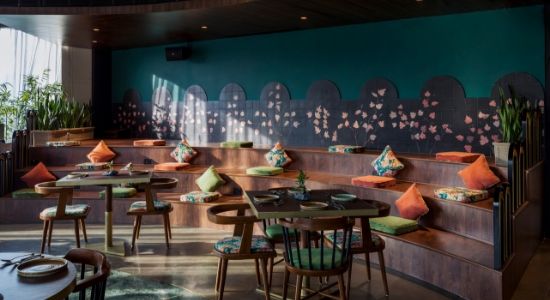
Lighting design and its strategy abundantly affect our perception of interior space. Natural light is being considered a foremost factor in cafes and brunch spaces. This has opened up a new avenue for chophouses putting forth the options for breakfast and lunch too, making them a go-to place. Dining and drinks for evenings, artificial lighting is added to create a bespoke ambience for a get-together or family dining.
Designs and concepts inspired by nature, providing an organic blend, with earthy tones of green, beige and blue bring the outdoor to indoor. Incorporation of reusable and raw materials are among a few popular themes gaining momentum in promoting spaces which are designed keeping sustainability as a highlight. This enhances the experience to be much more home-like and friendly, also prolonging the stay of your visit to the eatery.
Every colour has its own language; yellow signifies joy, happiness, and friendship, blue signifies peace, harmony and calmness, pink emanates romance, red says passion and beige symbolise pleasantness and simplicity. Each colour is thought through when being incorporated in the design whether it's for the walls, the furniture, the bar, or any other aspect of the interior to ensure it imbibes the story of the restaurant. Big clunky furniture has been done away with to make way for much more minimal designs to adorn the interiors.
Not to diminish the impact of furniture layout and the spatial arrangement, different setups are designed to serve a variety of clientele. This largely increases the engagement of people with the space reacting to interesting design themes of the mere seating layout of the space.
The extra-mile that we are expanding towards is to make these spaces more homely and comfortable, add workspace corners at new-gen healthy cafes or coffee shops, make them pet-friendly and provide an area where the new-age pop-up shows or networking sessions can be conducted. The idea is to provide a space where people of all ages can visit and not feel out of place.

As designers, we pull up our socks every time while approaching a new design project. It demands brand new energy, understanding the brief, the purpose, the cuisine and essentially reflect the restaurateur's vision of the brand. From there we orient a design philosophy to craft unique spaces.
Authored by Saniya Kantawala, Founder - Saniya Kantawala Design

Along the years of growing up, when Noida seemed like a barren playground to indulge in, Reverb disc surfaced up as the miraculous hub for all the youths to gather together to savor an ultimate nightlife experience as well as being a part of diverse Extravaganzas, ranging from never ending day jam sessions to multiple corporate events.

The restaurant has always come across as an absolute package to the Noida circuit of people. Being packed with people from different age groups throughout the day and night, it used to be the prime junction of interest. So, here comes yet another edition of the same, Reverb 2.0 to have you reminiscent about the good old times that you have spent, rambling inside this place which you once called, home.

Reverb Cookhouse & bar is the latest release of a luxurious diner & bar situated at the GIP mall, Noida. The place is oriented with the concept of palm trees, brimming the whole space. The thought behind the idea of the green leafy décor is to be in a close connect with nature.
As, you enter through the doors of Reverb, you will witness the hand painted ornate walls, in different shades of green with a huge projector placed on the left wall, displaying a myriad of music videos throughout the day. The next thing that will seize your interest is the magnificent bar, displaying a grand collection of liquor for all of you to quench your thirsty pleasures. The seating space on the ground floor, which is divided into two sections, looks opulent with teal green and red sofas with pam printed pendent lamps in each corner, enlightening the entire place.

One lies on the right of the entrance while the second can be accessed with the spiral stairs which leads to the section on the top. With the lights faintly dimmed in the chandeliers dropping from the ceiling, adorned with aesthetic artificial grasses and the beautiful music playing in the background, Reverb is the perfect venue to sit down and savour your share of composed conversations with your loves ones or your deal of important corporate meetings.

Before you reach out to the rooftop, there stands the console for our resident DJ at the junction of the stairs to keep you upbeat with music throughout your sweet time at Reverb. As you forward upstairs through the hallway, you will arrive at the three different sections of the sitting alignment which comprises of two uplifted areas while the middle one set on a low line, facing the charismatic bar furnished with the liquor of your choice. The prime console is set on the right side of the entrance to the rooftop which is constructed to organize live fiestas and to showcase talented artists, performing their art at their best. With the soulful ambiance around, the rooftop at Reverb will you be your ideal spot to get away from the hustles of the city.

The last and most crucial element of this place is the plethora of the dining course that we offer. Our extensive food menu is abundantly laid out with different world cuisines ranging from Mexican, Indian to Chinese and Italian, to please your palate with the best culinary revelation. So, here’s your destination, when you walk by, halt at Reverb Rooftop Cookhouse & bar to encounter a magical affair of some sumptuous food in mélange with a solitary yet exuberant environment at your best service.

Courtyard by Marriott, Mumbai has revealed their brand new step into royal elegance with a picturesque new project, Ummrao brought to life by Studio HBA.
Studio HBA has worked hard and fast to create a royal atmosphere without the clichéd ethnic setting of an Awadhi Restaurant. Ummrao aims to bring in the elite into their premises to experience a unique “Majestically Urbane” dining escapade between the hustle and bustle of Mumbai’s city life.
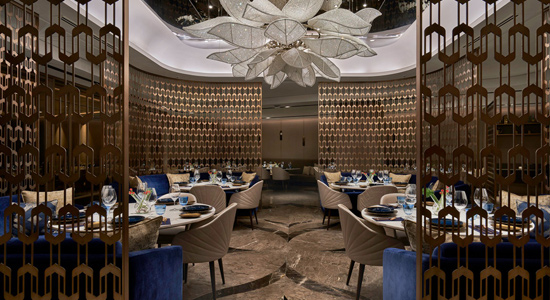
“The success of any project is dependent on the canvas we are given. In the case of Ummrao, we had a lot of interesting details to work with. The challenge of converting the asymmetrical space into an eye-pleasing and inviting symmetrical one was something our team was excited to take up,” shared Abhishek Mathur, Director, Studio HBA - Mumbai.
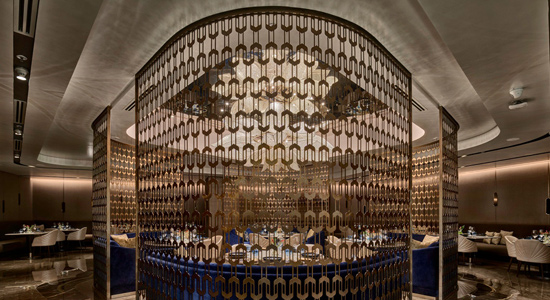
Ummrao is designed in a palette of warm colours that balances the glamourous elements perfectly. The botanical motifs on the handcrafted enamelled artwork beautifully ties in with the freshness of the menu that Ummrao offers.
“For the project our team has studied old palaces of India and infused it within the look and feel of the space. Courtyard by Marriott has always been a pioneer in terms of innovative thoughts and it was a fabulous experience collaborating with them on the project,” added Mathur.
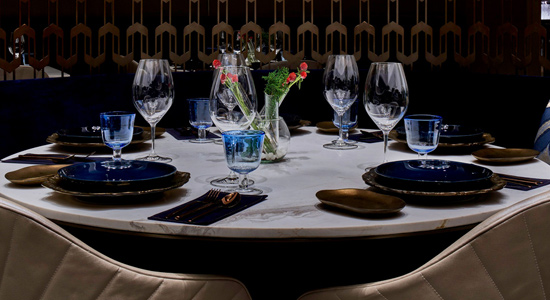
Lighting was an integral part of the design strategy and offers a moody and dramatic ambience which is punctuated with accents of decorative lighting. Perhaps the most elegant detail of the restaurant is the glowing lotus chandelier that acts as the perfect finishing touches while the gem cut mirrors on the wall provide an edge to the traditionally designed space.
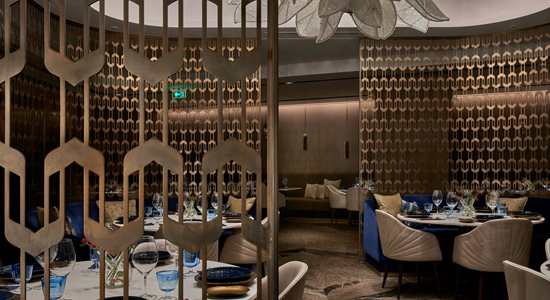
Studio HBA’s notable projects include Trump Tower Show Flat in Mumbai, Conrad Bangalore, Six Senses Spa Club Mumbai and LodhaWorldone Marketing Suites in Mumbai.

Like fresh Spring breeze, Gurugram is welcoming the new Tex-Mex cafe Pablo- The Food Cartel. Enjoy the delicious cuisine from Italy and Mexico while sitting in the vibrant, classy & beautiful ambiance.
Hop in with your friends or carry your favorite book to enjoy the time with yourself and indulge in the array of scrumptious food and great variety of desserts.
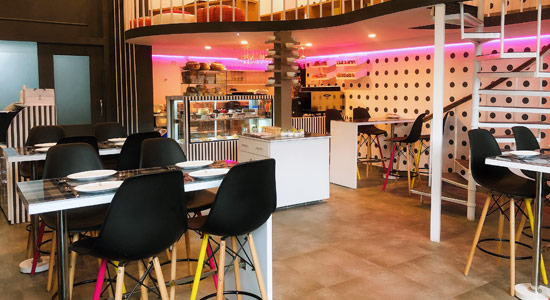
The café is the brainchild of young sister duo Priyanshi & Sanchita Dhir. Pablo is a mid size beautifully designed chick cafe in upcoming market of Golf Course Extension Road in Gurugram.
MAY INTEREST: Delhi Gets First Eloquent Kitchen And Bar - Anardana
Pablo is not just a cafe it’s an experience we want you to feel. With the mix match of subtle ambience and vibrancy complimented by coffees from around the globe and palate refreshing food. The café has a seating capacity of 40 people and is divided into two sets, ground floor and mezzanine floor.
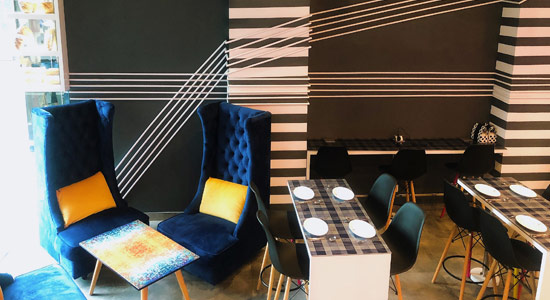
The interiors of the place are kept classy with mood changing lights and bright yellow lights. It offers a variety of seating options from high tables & chairs to tyre couches with low tables. Serving the best coffee from 8 different countries in town like the Mexico, Nicaragua, Colombia, Kenya, Panama, Brazil, Ethiopia, Gungegiri.
“Coming from the family of caterers, our parents always wanted to open a café chain which provides unique dining experience with focus on cuisine which is not usually found amongst café menu”, says Priyanshi Dhir.

The café plans to open next two outlets in span of three months in Gurugram city and soon to open in Delhi too.
The menu includes delicacies like Flourless chicken pizza, Bacon wrapped Artichoke, Arancini, Fluffy omelet, Soba noodles salad, Pesto Risotto and Arancini, Panna Cotta, Blue Berry Mascarpone Cheese Cake and Opera among others.
ALSO READ: Inheriting Traditional Appeal With A Touch Of Victorian Era
The cafe serves eight types of coffee from eight different countries along with delectable Mexican & Italian delicacies.

“Both of us were super keen to put a step forward and enter the food industry. And this industry is not easy to survive in, I am sure everybody knows,” shares the Dhirs.
Entering the catering world was moving one step ahead, the walk was tough but was not tiring and it was full of thrills and excitement. The duo knew that something was left that had to be done. And it is finally here “PABLO- The food cartel. All the hard work for all these years gave a birth to this baby.

Designing a restaurant with utmost detail is important. People these days go to a restaurant not just to have food but to relax and enjoy the ambience. Hence, it is becoming very important for designers to keep an eye on every minutedetail before designing a place. As they say, people eat with their eyes first!
Jumjoji, a Parsi restaurant located at The Orb- JW Marriott Sahar, Mumbai, is designed by the Malcolm Daruwalla, Principal Architect of the Seedle DC Group that has designed some of the luxury retail and restaurant spaces, homes and gyms in Mumbai.
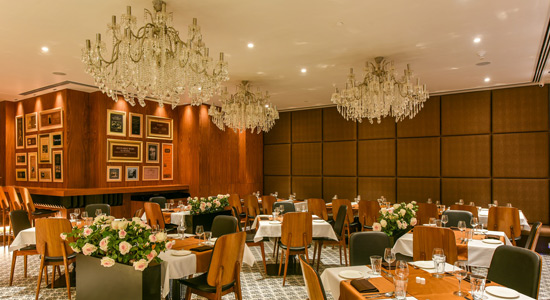
The interior and decor of Jumjoji has been created with an aim to showcase Parsi culture in its most authentic form. The design elements of Jumjoji present the rich heritage, culture and legacy the community has. With the use of wood, marble and artistic tiles, the walls of the restaurant are used to portray facts and stories of the traditional Parsi culture.
“It was important for us to express Parsi culture in its most authentic form vs any stereotypes. With all the rich heritage, culture and legacy the community has, we wanted to create a place that Parsi’s can feel proud of, a place where they can walk in with their family or close friends to celebrate good occasions while proudly showcasing what the community is all about,” shares Daruwalla.
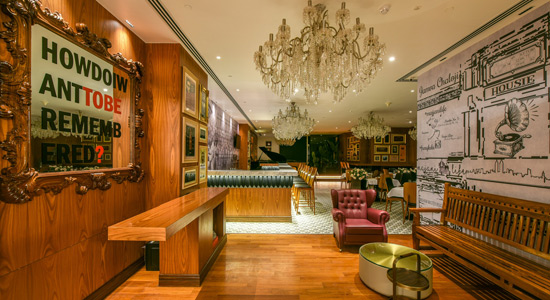
Besides the use of wood, marble and artistic tiles,the walls of the restaurant are used to tell stories. The wall behind the bar counter narrates how Parsi’s came to India while the other walls narrate actual recipes and facts.
The furniture, chandeliers, sculpture and graphics are all created in-house by their highly skilled team of craftsmen, artists and fabricators. Parsi homes always feature natural materials and so it was a natural decision to use wood as a major element in the design plan.
Warm lighting and patterned floors are signature elements in Parsi style. Inclusion of all these elements makes the space feel subtle but grand. “We wanted to make sure that we enhance the Parsi experience that the client wanted to offer. We wanted to create the same grand feeling that a Parsi home has and also retain the subtle elegance that the culture encapsulates.” He adds.
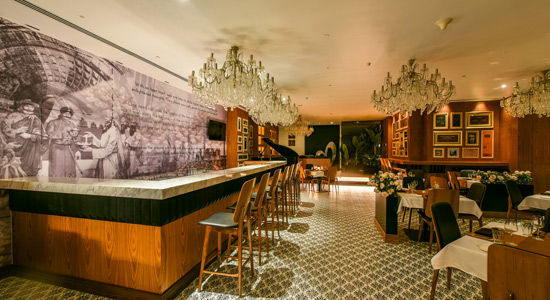
The menu is beautifully crafted with food and beverages menu that includes typical parsi food including parsi salli boti, dhansak, and berry pulao including some chicken and prawn starters. Whereas, the beverages menu include drinks like chilli guava, whisky sour and cosmopolitan to name a few. The desserts are also handcrafted with their pudding and sevdahi to name a few.

From the house of ‘Punjabi by Nature’ and dotted with vivacious ornamentations, Beer Bahadur located at the Ambiance Mall, Gurugram, serves as a fitting semblance to relish the enlivening tone of innovation executed. Original concept of the diner was conceived to be family centric with a muted environ but it underwent a ‘Midas’ touch’ and now poses for a dynamic setup with requisite quirk.
The design was driven by an incentive thought of bridging the gap between younger generation and traditional dining styles. In the words of the principal designer, Ar. Abhigyan Neogi, “With Beer Bahadur, we have attempted to go out on a limb and create a memorable and personal experience that beckons to the passionate and adventure-seeking youth of today”. Thus, unlike its preceding design scheme, the current composition is more out-going and has a bold impression to it that leaves one spoiled for choice with a multi-faceted ambience.
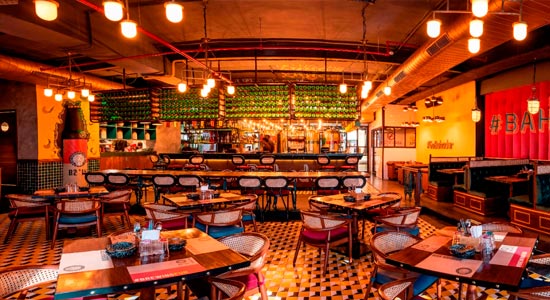
The restaurant is fronted by a narrow porch with a range of seaters placed along that to serve as a prelude to the interiors. Since it is almost a natural expansion of the mall’s corridor, this porch allows one, to experience a gradual shift in the ambience as one traverses from the mall to the restaurant.
Upon entering the devised interior setup, an individual is welcomed by a pleasant sight of persuasive vibrant interiors. The first glimpse, on the left, is cited by a smoking room designed to resemble a washroom which allows the user to experience a completely new and unparalleled encounter that one will remember for its exclusivity and individuality. While the room offers the element of privacy, it still maintains a link to the rest of the eatery through windows on its two adjacent walls and, thus, does not remain completely unapproachable for users on either side of the zone.
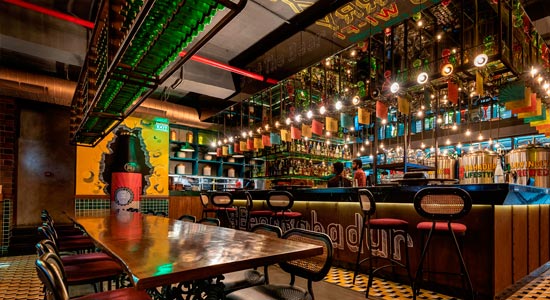
The centrally located bar, serving as the focal facet, may be deemed as a masterpiece in itself and has been further enhanced by the use of supplementary installations including a strip of trumpets above. The trumpets have light bulbs installed in their bells as an introduction of an innovative lighting addition. With colourful flags hung below them, these make for an eye-catching inclusion to an equally decorated bar.
The arena in front of the bar is occupied by a long wooden community table, topped with consequent rows of green beer bottles. This sustainable approach utilising a residual element for aesthetic embellishment, is arrangedin a rusted metal frame hung from the ceiling. The multipurpose table can be used by patrons of divergent configurations, owing to its transverse spans differentiated in two levels, with row of chairs on one side and bar seating on the other to counter the disparity.
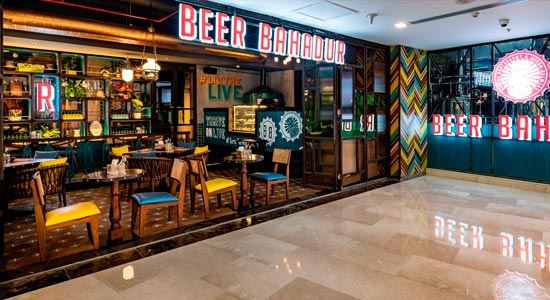
Advancing further, the design is directed towards the primary service provision section-the kitchen. While it is enclosed with only the staff allowed in, customers are allowed to interact at a minimal level through a longitudinal window at a certain height. This sliver of visibility, while maintaining privacy and posing for efficient space planning, adds afactor of interest, almost as if one is allowed for a brief peek of “behind-the-scenes”. The rest of the restaurant features tables for four and booth seating with plush, suede-upholstered sofas for six and eight. Supplementary assets, including a DJ counter and LED screen, further makes the atmosphere impeccable for the target audience. The interior schema, thus, is primarily divided into various zones with a subtle play of levels that blend into each other, allowing for a gradual yet noticeable variation in the setting.
The colour blue has been predominantly used for décor, with accents of burgundy that enriches the spatial texture. Pop colours shades of yellow and pink have been used extensively for the graphics and slogans. The walls are highlighted by a carefully orchestrated collage of handmade green tiles and exposed brick.Yellow also features repeatedly, in the flooring tiles and furniture. The commuting flow is differentiated into virtual zones, identified by varying flooring patterns. Yellow and black patterned tiles demarcate the seating zones while black pandomo flooring emphasises on the circulation. The porch at the front has a pandomo flooring along with an assortment of exposed brick and patterned tiles. The entire place maintains harmony dimmed yellow lights for a relaxed and a calm acquaintance. Rustic lights hang from an exposed ceiling,creating a subtle combination of premium and raw. The vibrant graffiti and eye-catching installations amplify the spirited vibe and an energetic interactions of the users.
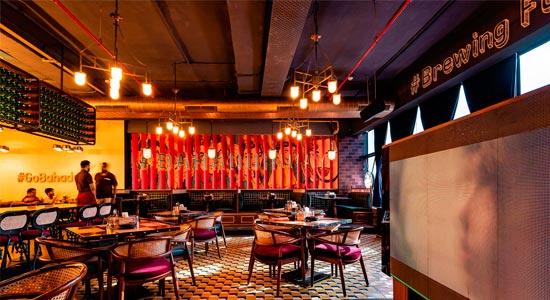
Beer Bahadur, thus, not only offers a space to simmer down and delve into an eccentric setting but also confers its users with an opportunity to experience a cacophony of essences, executed through this flamboyant design.
FACT FILE:
Project name: Beer Bahadur
Architect’s Firm: Chromed Design Studio
Design Team : AbhigyanNeogi, Kanika Suri, Deepannita Majumdar, Dhruv
Project location: Ambience Mall, Gurugram
Commencement: December 2017
Completion: September 2018
Gross Built Area: 3900sq.ft
Photo credits: Arvind Hoon
Furniture : Khurana Steels

Designed by refurbishing an existing heritage site Garage Inc. is a modern style café located in Colaba, Mumbai. The raw textures and appeal of the whole café has been kept in mind. The café design is in sync with the whole city fabric in its raw, archaic and rustic feel. The 28-year-old fresco, ceiling and flooring has been left untouched to retain the old world charm, the ambience speaks loud and clear about the café being a relaxing space. Also, the café has a certain industrial feel attached to its design.
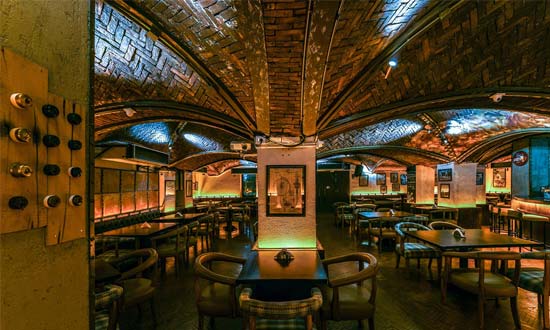
The Idea
The café is situated on Walton street in the Plush area of Colaba in Mumbai. The idea of the café was to create the space that has an American vibe attached to it and at the same time preserve the beautiful heritage site with unique Indian architectural elements such as the curved brick roofing and the terracotta tile work on the floor. The most enthralling idea was to use natural tones of brown. Natural shades of brown have been used that prove to be a versatile hue with its wide usage in American as well as Indian indigenous architecture.
The main door or entrance of the café opens up on the main road, the café lies on the ground floor. As the user enters the café they are greeted with a wide vista of the magnificent café interiors. The wet areas and dry areas are segregated well with the bar kitchen and washrooms placed at the end of the café on the right side keeping in mind the smooth functioning of the café during rush hours.
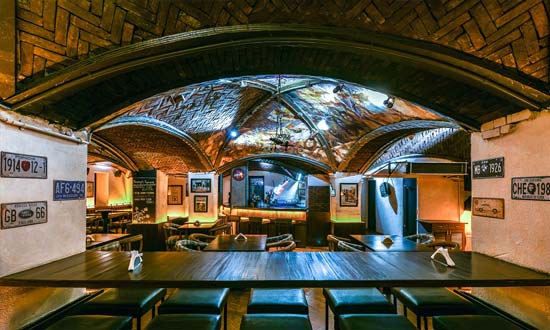
Playing with Design
Garage Inc. is a watering hole celebrating such creative and innovative minds and places of work. The name ‘Garage’ comes from the idea that great ideas are flourished within small minds.The café’s design is replete with rustic, industrial and out of the box design elements that compliments the nostalgic vibe of the whole space. Be it the hipped roof ceiling with unfinished paintings or the terracotta flooring the café is designed to remodel the aura of the former property. The roofing and flooring have been preserved in its purest form and walls have an unfinished fish scaled texture adorned with various wall hangings depicting inventions and discoveries made in the past.
The restaurant is spread across a vast area and houses plenty of wooden tables and comfortable wooden chairs and couches strategically placed in, while ensuring enough space to move around with ease– a good example of well executed space management.The chairs are alternatively designed with a very easy to miss feature of mixing different fabrics which proves to be another unsaid move by the designer. The beige and mustard checked fabrics with copper button work detailing gives the furniture an edgy look. “The monotonous colour palette used adds to the charm of the place making it pleasing to eyes because of absence of pop and neon colours, the muddy brown roof and flooring add to the indigenous effect of vernacular Indian Interiors,” shared Arushi Bansal. Modest shades of brown and mustard have been used for the furniture while the walls are adorned with beige hues. The bar area witnesses the use of blue coloured wall elements that are highlighted by blue lighting. “The design team decided to preserve the existing elements and use common grounds from the client brief, site and design sense to create a well-crafted masterpiece that has plenty of design elements,” added Love Chaudhary.
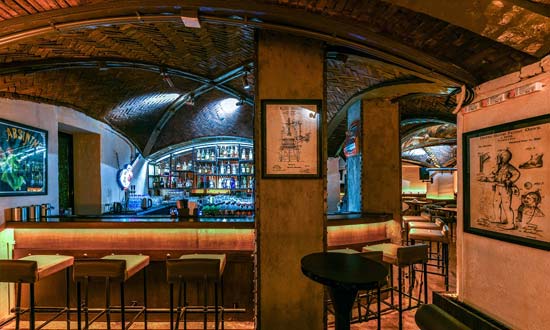
Focusing on Sustainability
The project is a design triumph in itself at the same time it qualifies to be a sustainable project because of the fact that it does not unnecessarily use design elements while destroying the existing ones, rather the design team believes in sustainability and avoiding wastage of resources. The Garage Inc. proves does not miss a single chance to enthral the use with its rustic and indigenous design feel and garage inspired interiors.
FACT FILE:
NAME OF THE PROJECT – Garage Inc.
LOCATION – Walton Road, Colaba, Mumbai
DESIGN TEAM – Ar. Love Chaudhary, Ar. Arushi Bansal
TOTAL AREA – 3650 sq.ft.

As affluence and professional pressures overtake daily life, the experience of fine and casual dining is about so much more than what’s on the plate –it is guided by good service and increasingly, an excellent ambience. As an architect/designer, the challenge lies in delivering an immersive experience and not merely redoing a space to improve aesthetics. Group DCA's design philosophy behind conceptualizing restaurants is driven by a focus on spatial setting and augmenting aesthetics keeping in mind the client’s sensitivities and cost-effectiveness.
Having carved a niche in the hospitality sector, some of the design essentials lay utmost importance on the following:
Façade
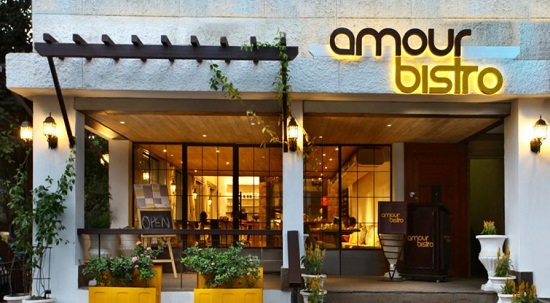
Photo Source: Group DCA
The façade of any restaurant casts the very first impression on the customer. It is one element that needs to reflect the aesthetics and individuality of the outlet and also engage with the users. Needless to say, it needs to be inviting.
Spaces
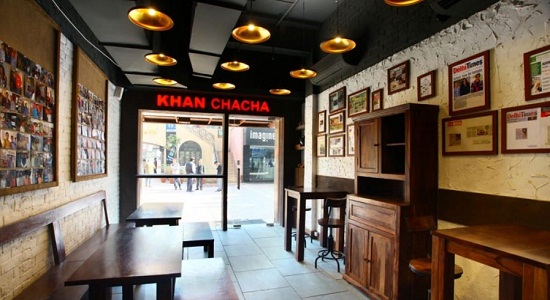
Photo Source: Group DCA
Every space in a restaurant should work together, to create a unique experience that will keep customers coming back. Space efficiency, smooth circulation and easy egress guide the layout of the dining room. Kitchens need a detailed design for clearing air through exhausts, maintaining hygiene through ease of cleanliness and ensuring the quality of food held in storage. Standards of safety, fire protection, ventilation and other building codes must be designed to work hand-in-hand.
Must Read: Restaurants Must Have Proper Structure And Design, Else They Will Collapse
Lighting
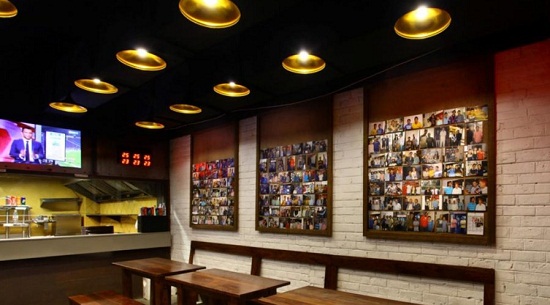
Photo Source: Group DCA
Lighting forms a crucial part in creating the overall ambience. Sunlight imbues restaurants with a fresh lightness that is essential to daytime entertaining. As the day progresses, warmer lighting can work with the setting sun to create an ambience that is best suited for a coffee or sundowner. Warmer tones craft mellow, casual spaces, while white fluorescent lighting creates a bright, clean feeling.
Detailing
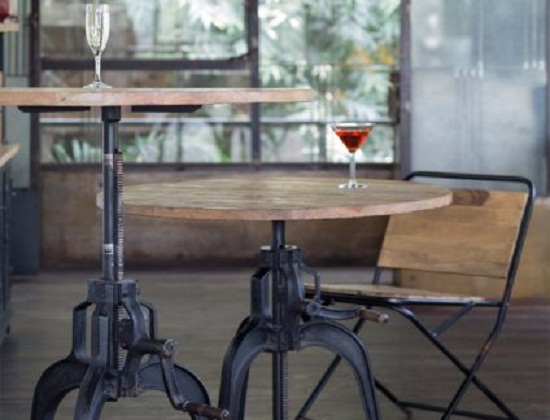
Photo Source: Group DCA
Starting with the entrance and percolating down to the tiniest detail, a restaurant must reflect the character of its owner/brand. People are increasingly looking for spaces that reflect their individual interests. The integration of individual motifs and quirky elements helps the users to relate to space better and develop a sense of belonging to space.
Conclusively, the experience of a customer is the ultimate test for the design of a restaurant. Every brand is unique and has its own USP, targeted towards a more specific audience. But, it is also popularly stated that a function or a notion of something can be productive, only when the space it is placed or conceived in, allows it to. Group DCA strives to achieve this by striking the perfect symbiotic relationship between branding, spaces, and most importantly, customers.

The article is contributed by architects Amit Aurora and Rahul Bansal of GroupDCA.
GroupDCA is an award-winning architecture and interior design firm and is spearheaded by Amit Aurora and Rahul Bansal. The brand has to its credit, remarkable, award-winning, widely acclaimed projects across diverse typologies such as residential, retail, hospitality and workspaces.

SpeedX has been disruptive with its custom-made bars, product design, quality and unmatchable after-sales service. Anirudh Singhal founded SpeedX, the bar design brand, in 2014 with an intent to create inspiration and innovation in bars. While the global landscape of the food and beverage (F&B) industry was undergoing a massive change, the minds behind SpeedX understood and weighed the gap in the market. Foreseeing the exponential growth of the industry, the bar design brand, since then, has been experimental in bringing great innovation and quality to the beverage sector.
In an exclusive interview with Restaurant India, Founder of SpeedX, Anirudh Singhal talks about the design approach of the bars that ensure faster service and prompts an increase in the sales.
How would you define the first bar designed by SpeedX?

The first bar that Speedx designed and built was Khar Social, Mumbai, in 2015; it was a collaborative effort between us and the team at Social. The bar counter was an island (of sorts) with three sides, serving guests — the layout was planned in a way it allowed the bartenders to serve on all three sides while working on the central island counter.
Must Read: People Prefer To Drink Scotch At Home
This central island was a mother cocktail station propelling drinks to all sides of the bar counter. So, when the bar was in full swing it appeared as if the bartenders were collectively preparing drinks on a central piece of equipment, and then turning around and serving the tipples. It all looked theatrical. And this happened three-four years ago! Only a few bars look like the way Khar Social does. It was quite a cutting edge.
What innovations did you bring with Speedx?
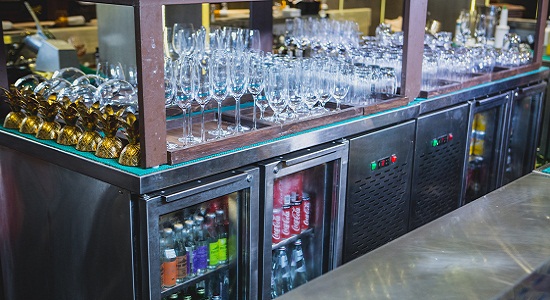
Earlier, our focus was to create bars that could aid in showcasing bartenders’ craft. But now, our prime concern is to make a bartender’s life easy. Hence, we introduced the concept of drip trays in bars as opposed to the rubber mats. Drip trays are a common practice in western countries; not much popular in India. These trays, on guest counters, allow bartenders to prepare their drink with the glasses placed on them. This way a bartender showcases his skills and creates visual excitement to other patrons in the bar.
Second, we noticed, the bartenders would stand far away from the guests at the bars which minimised the interaction. We designed equipment which wasn’t deep, thereby, getting the bartender up close and personal with the guests.
Also Read: Bar Equipment Design Trends For 2019: Slushies, Tipples On Tap
In certain cocktail station designs, we even have curved speed rails to bring the bartenders closer to the guests.
Third, to ensure a quick turnaround whilst preparing a cocktail, we introduced the concept of rinsers in bars. The concept is popular in many fast-moving bars abroad. These rinsers work on the principle of hydraulics. As soon as you finish mixing a drink in a glass, you can turn it upside down over a rinser. A gush of water comes out to rinse and makes the glass ready for the next drink. The same can be done for cocktail shakers and other mixing tumblers. This propels bartenders to get into the next drink faster without wasting much time on rinsing activities.
These are some of the innovations which keep us ahead of the curve when it comes to the Indian bartending equipment market.
Your approach to designing bars?

We ensure the principles of ergonomics are adhered to, and everything a bartender needs is at an arm’s distance. Also, the Speedx equipment is anthropomorphic, in other words, very intuitive to use and one generally doesn’t need training or a manual to use them.
How the bar designs have evolved in the past four years?
Overall, bar designs have taken a leap of faith in the last four years with architects, interior designers, promoters and restaurateurs doing a fantastic job of creating venues, especially in design, which are sometimes better from the ones we see at international bar space.
Earlier, the restaurant entrepreneurs would end up hiring kitchen designers to plan their bars. That was suicidal! Imagine a person who has never worked in a bar and gets to decide where the sink or ice-bin would be placed. This practice set a base for complete disaster. Just because the bar is wrongly set up, the guests complain of slow service.
This is changing now. With more F&B concepts being beverage-centric, a lot of focus is put on overall plans, especially on how the bar should be, how much space should one allocate and the location. Now, there are restaurateurs who brief us the concept of their restaurant, this helps us in the design.
Challenges in designing a bar?
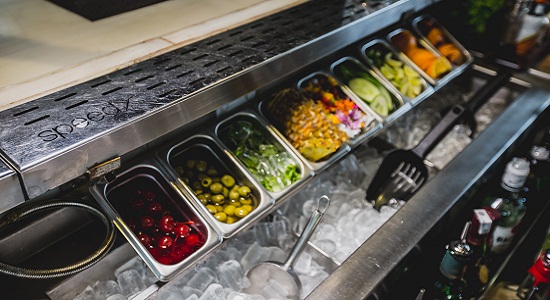
The biggest challenge we face when we set off to design a bar is the paucity of allocated space. At times, the bar space gets the step-motherly treatment from the restaurant owners. In such a scenario, we try to optimize the space available by creating designs that augment cocktail/beverage dispensing in the minimum space.
Another challenge is to integrate beers on tap and the rest of the equipment inside a bar. A lot of bar owners want different variants of craft/draught beer (which is a great thing), but the equipment and accessories that come along with these bars end up making the layout quite haphazard. Thus, it becomes an obstacle in planning a proper bar layout. But we have come up with custom-made solutions where restaurants can set-up their own draught beers; alternatively, we liaise with all beer brands to ensure streamlined installations.
Also Read: Will Gin Be The Next Big Trend in 2019?
Another common problem is the height of the bar counter. A lot of venues have to raise the floor inside the bars to accommodate plumbing requirements. This makes the guest counter look quite high. We try to customize the height of our equipment in order to leave enough working space for the bartenders.
Your dream project?
We take every new Speedx bar project as it’s the most important. Designing and building my own bar would surely qualify as a dream project. But that will have to wait for now!
Things to Know About SpeedX
Restaurant Bars Designed by SpeedX
Some of the renowned restaurant bars designed by SpeedX are - House A at Hyatt Regency (New Delhi), Olive restaurant (Bandra in Mumbai), Social (Delhi and Mumbai), Café Delhi Heights (Delhi and Mumbai), Fatty Bao (multiple locations), Punjab Grill (multiple locations), Cin Cin (BKC, Mumbai), Mamagoto and Sly Granny’s (multiple locations), Bo Tai, Qutub (New Delhi) and many more established players.
Products Offered
SpeedX offers the best-in-class chillers, refrigerators, simple bottle coolers, mug chillers and even drawer refrigerators.
Complaint Resolution Policy
SpeedX has a 24-hour resolve policy.
Future Plans
The bar design brand is now taking projects to create bespoke bars for luxury homes, villas and entertainment centres.

Transporting delight to the sight, the antique lights and chandeliers contribute to its antique décor. The use of wood and bronze in the decor is prominent which also creates a cosy ambiance and facilitates quality conversation.you to an era between ‘Vintage’ and ‘information overload’, Dubai’s famed British gastro-pub ‘The Stables’ open its door in Mumbai.
Embodying a rustic personality and country vibe this artistic space features a blend of class and sass. With a cross cultural value and approach in all its elements including music, art, food, cocktails, The Stables is set to cater a global consumer.
Bringing you a whiff of nostalgia in its design and menu coupled with a melodic touch and an artistic charm, The Stables assures you a unique experience. At the helm of this intriguing concept is the Board of Directors leading a chain of Hotels under Peninsula Hospitality PVT. LTD in Dubai and Gautham Hospitality PVT LTD, Competent Hospitality PVT LTD in Mumbai - Rahul Shetty, Gautam Shetty & Gaurav Shetty who also happen to be brothers.
“Today’s audience is gradually retreating from the typical party culture to more going and relaxed ‘sit down’ culture which constructs or enhances socialising & quality conversation as they enjoy phenomenal music, food and drinks,” says Gautam Shetty, Board of Director, Co-owner, The Stables - Mumbai.
Inspired by the tales of historic horses like Sherghar, Sea-Biscuit, Barbara, Red Rum, Secretariat to name a few, this restro bar is celebrating the simplicity of life, seeking an out of city experience, wanting a creative hub to revive one’s soul or shifting one’s meetings from an office cubical to the bar, post work hours; this earthy space is designed to cater a global audience with a diverse set of likings.
A delight to the sight, the antique lights and chandeliers contribute to its antique décor. The use of wood and bronze in the decor is prominent which also creates a cosy ambiance and facilitates quality conversation.
The diversity in its characteristic is effortlessly replicated in its cuisine, cocktails and music coupled with ‘performances’. The cuisine presents an array of flavour profile including European, Continental and Oriental. Starting with the ever classic salads, finger foods then progressing to the entrees and ending your meal with some delicious desserts, you can make your choice between, ‘Braised Lamb Shank’, ‘Baby Back Ribs’, ‘Seared Salmon’ to ‘Tiramisu’, ‘Dulce de Leche’ including many more. With a wide selection of Whiskey and Wine, there are quite a few cocktails with interesting stories inspired by the horses like ‘Oscar Sangria’, ‘Cribber Ascot’ and Stables Grog amongst the others.
The music plays an important role in binding the vibe and its tribe together. While presenting well curated live music performances and bringing back the ‘Jukebox’ concept, the melody graph ranges from multiple forms of Country, Jazz, Latina, Reggaeton to a array of carnival and celebratory tunes, The Stable will be featuring many interesting musical IP’s, ‘Artistically UnStable’, ‘Melody Reconstructed’ being the core ones.

Disrupting the status quo
I think we are bringing a bit of the corporate edge to design which seems to be working very well for the projects and has been appreciated by our clients as well. Let me explain. Designing ideally is how you start the process. We burn the midnight oil and sketch and build it on paper. However, come morning and the ideal design needs to be broken down to a process. It needs to be documented, there needs to be an order to the drawings, a process to the communication and only then can a design be rendered the way it was imagined.
Our 13 odd years in the industry have taught us that the lack of implementation is what kills design in most cases and causes a discord amongst the client and consultant. I think we have successfully managed to bridge that gap and it has worked to our advantage. So to sum it up, our ability to finally bring design down to a process and quantify the deliverables-without diluting the design in any way is what will cause a ripple in the status quo.
Practicality of biz
Apart from the projects we have done and the spaces we have created, which we are deliriously proud of, I am extremely proud of the fact that I've been able to run my company like a business and yet not let the practicality of running an organization dilute design. We design from the heart and commission it ruthlessly. The ability to justify both, I believe has not only been my greatest achievement but also my greatest strength.
Overcoming challenges
There have been many. We came to a point in 2012 where we lost everything we had worked for since the beginning of my career and came crashing down and owed the market an amount that took us two years to pay back. That was an all time low. I was struggling to just stay afloat every month. The high point was paying off all our debts, and bouncing back and bagging some of the best projects the country had to offer in F&B after that. But what I feel was my biggest high point was managing to live those two crushing years with dignity and pride with my head held high and emerging out of it without anyone's help. I talk about it with a smile today but I remember living it out on my own that time and it was extremely overwhelming on most days. That experience has made me who I am today.
Expansion is on radar
So far our business has concentrated on design consultancy which does not require any external investment per say. We are however looking at floating two new ventures this year. One will be This It It Homes which will again be a design consultancy for houses and the other company will design and commission light installations. There will only be one of a kind and will be custom made to the client's needs and the space. We will see what kind of a growth pattern that has over this year and hopefully, we will be raising some external investment for that. We hope to take the brand global and we are already working on a few projects overseas.
Boasting the design
To take the brand global and represent India as a state to be reckoned with in Design. We hope to do product design, start a division for Interior styling, commission art installations, do concept based hotels and of course, my first love, put a restaurant designed by This Is It Designs in every corner of the planet. I want the name This Is It Designs to be addressed as a design firm that did its bit in tying together the countries and continents and cities in a small way. It's time that the lobby for Unity stood taller and stronger than the Lobby for War. Art and design plays a key role in that and I am hoping to contribute to that.
Copyright © 2009 - 2025 Restaurant India.














